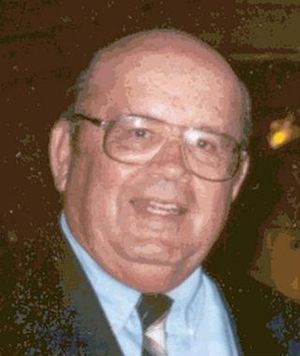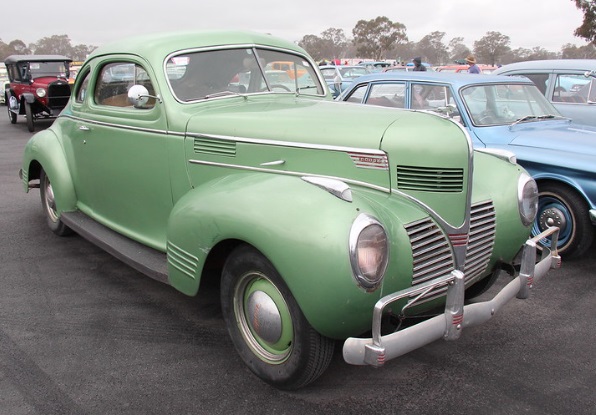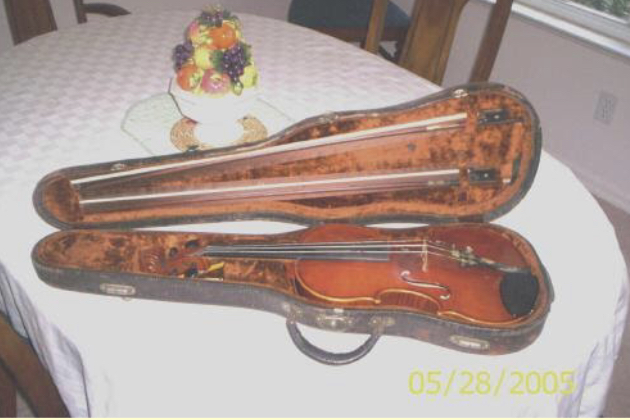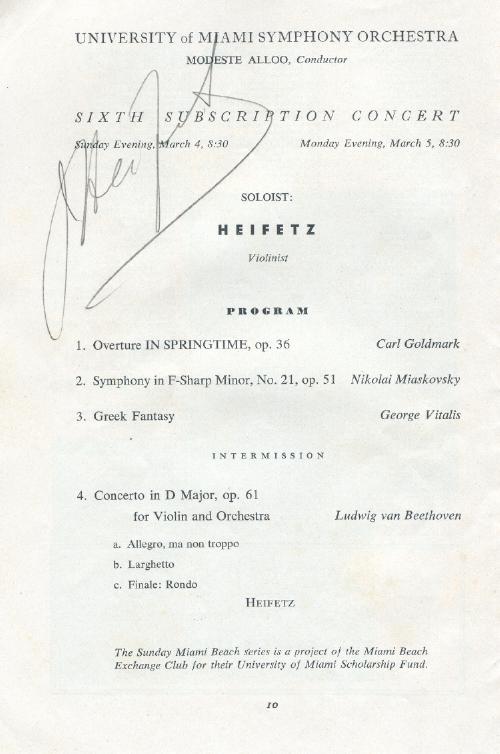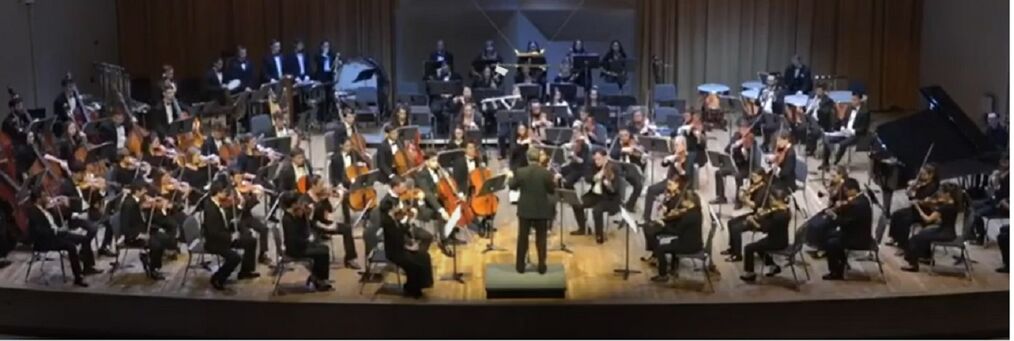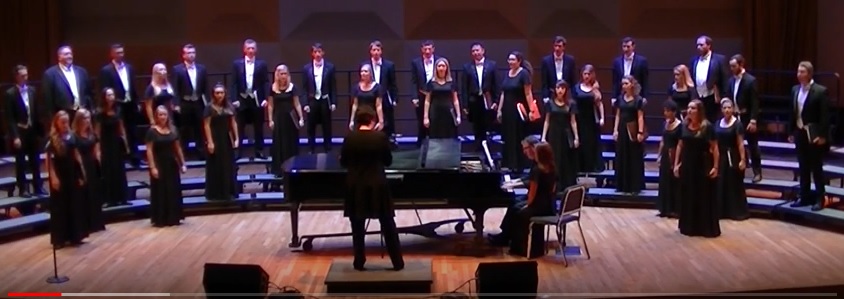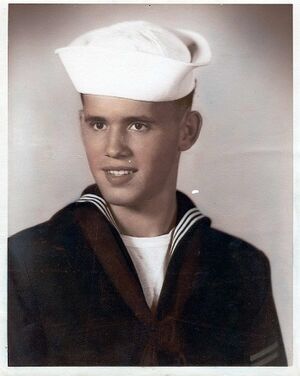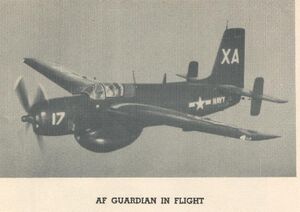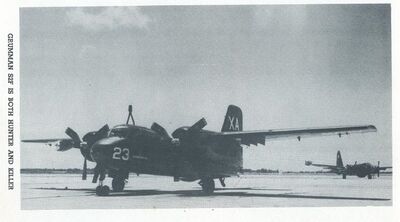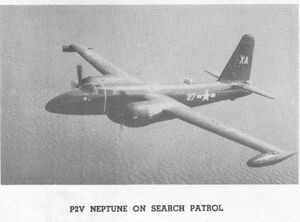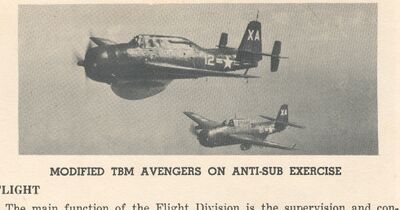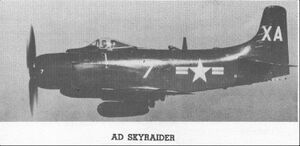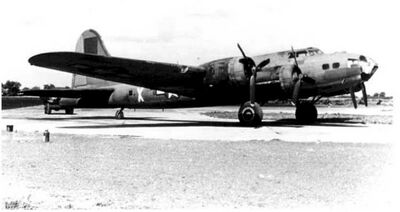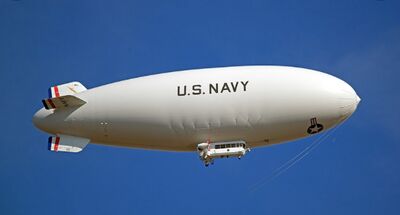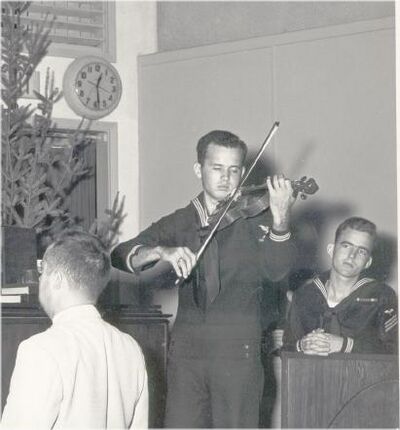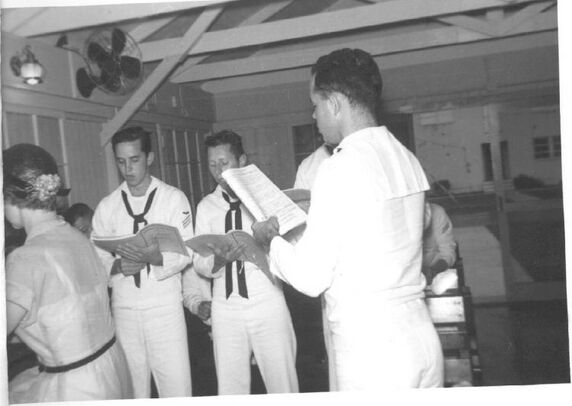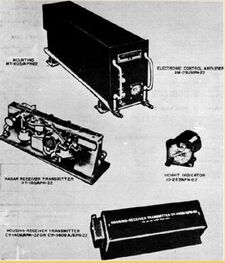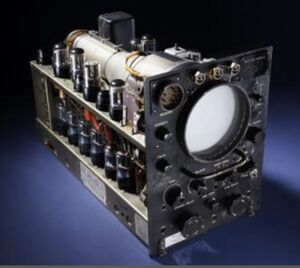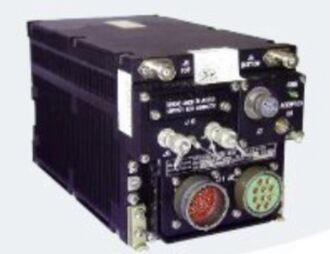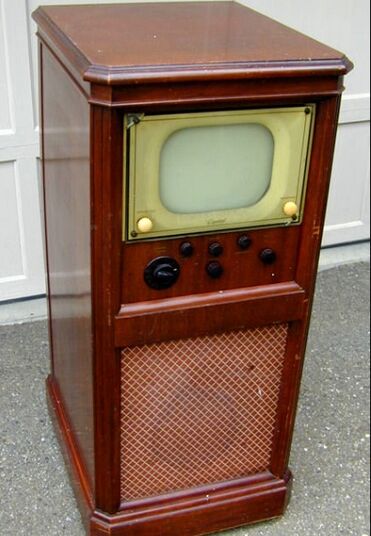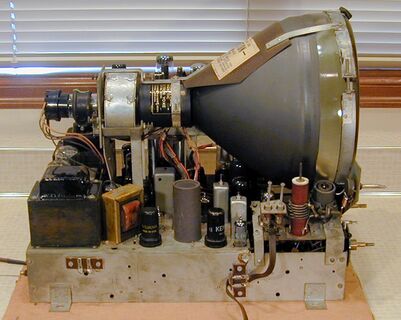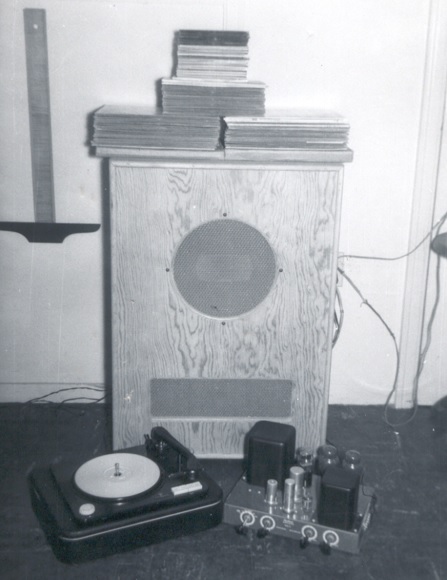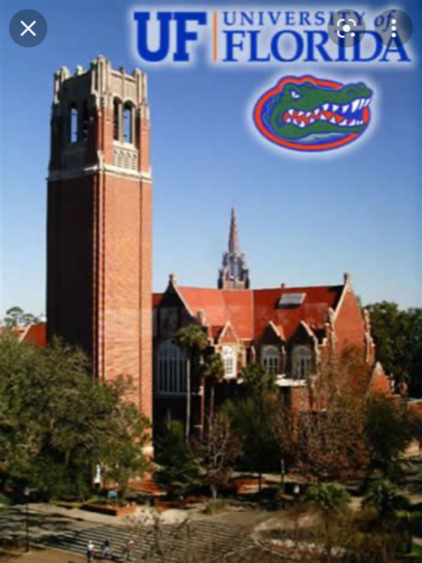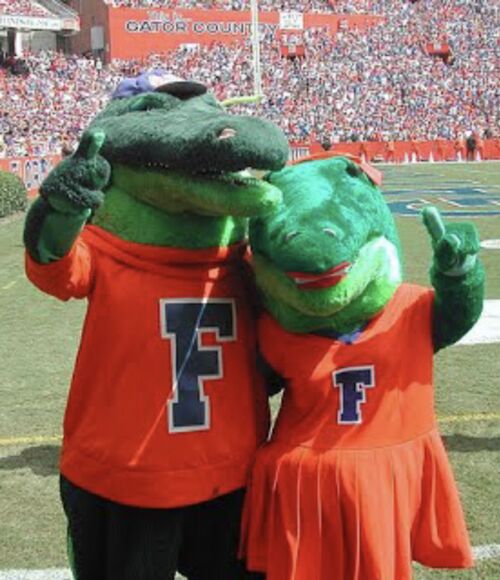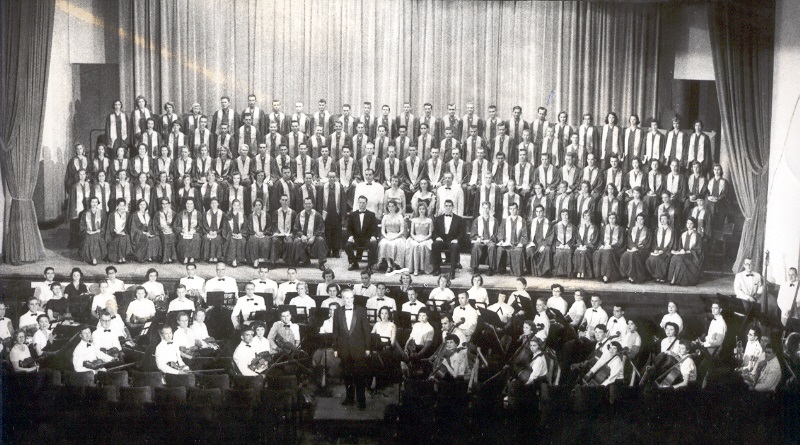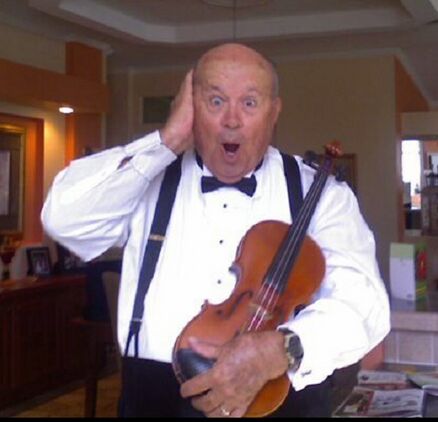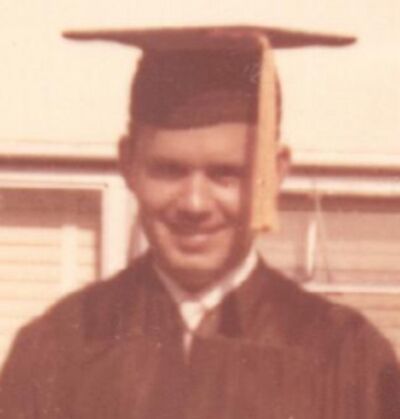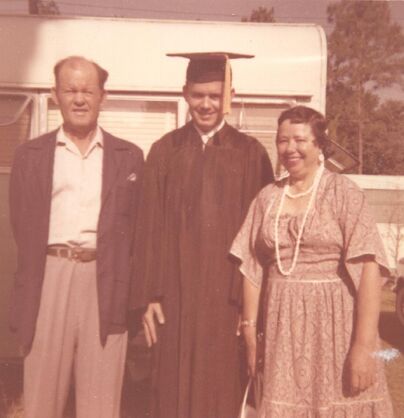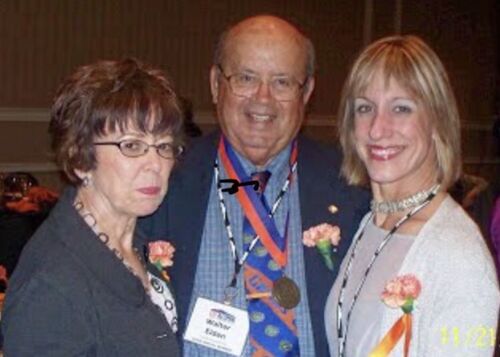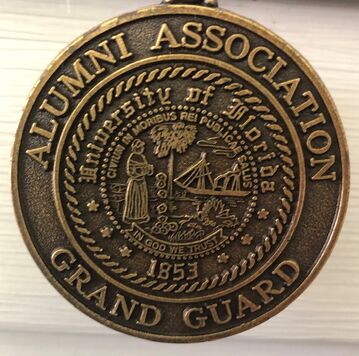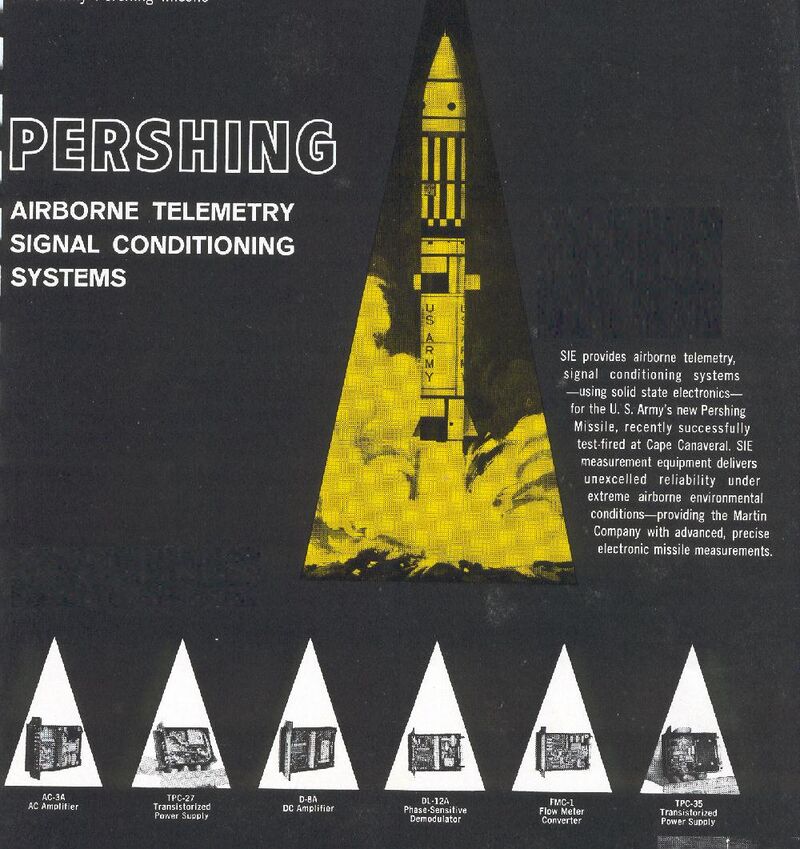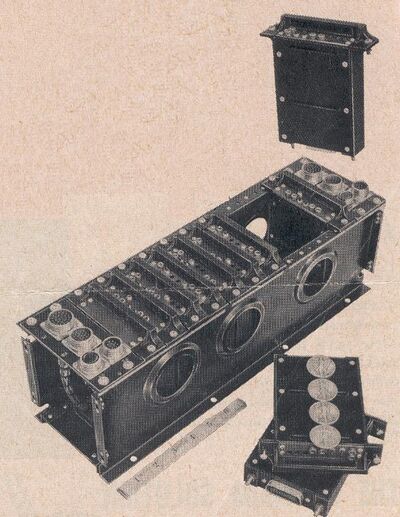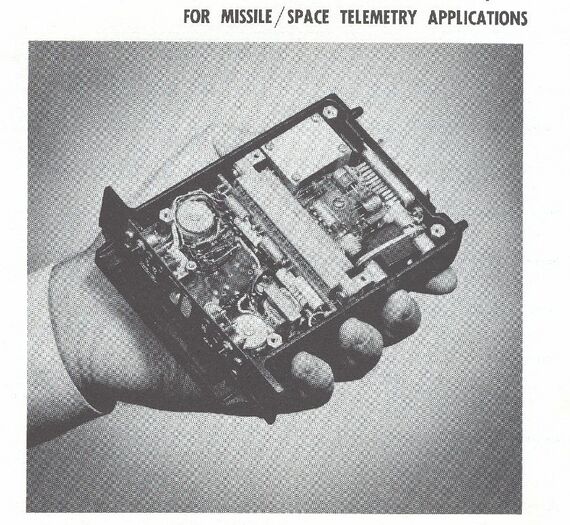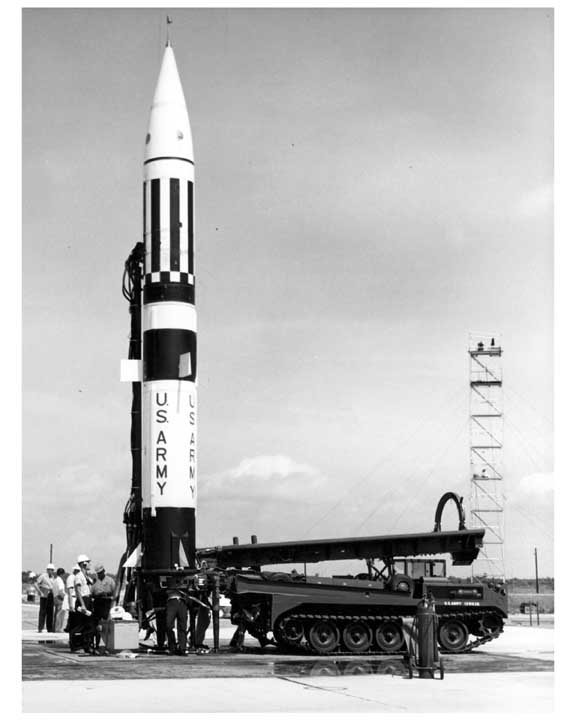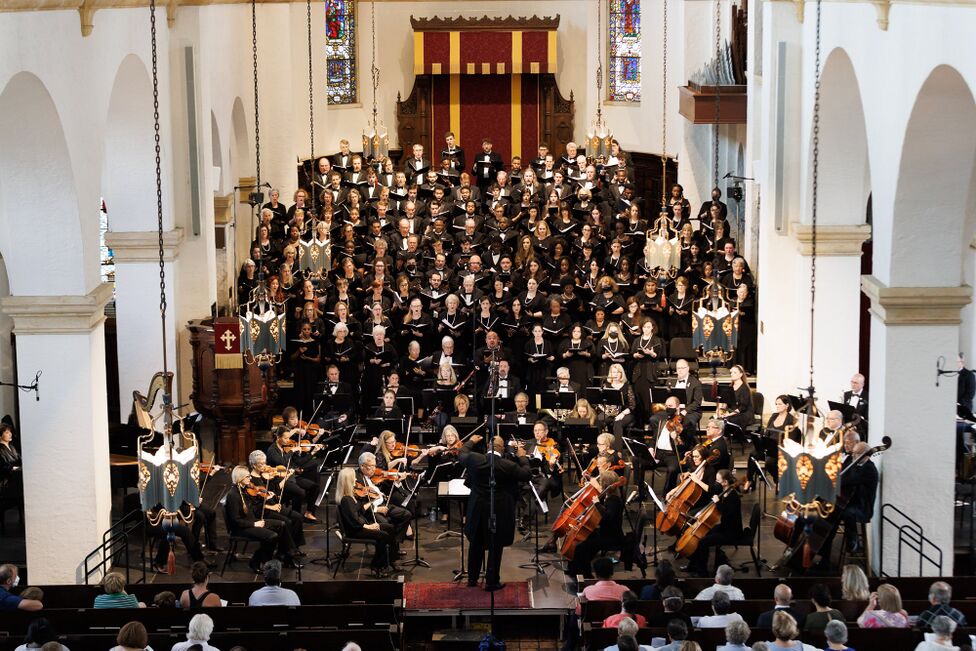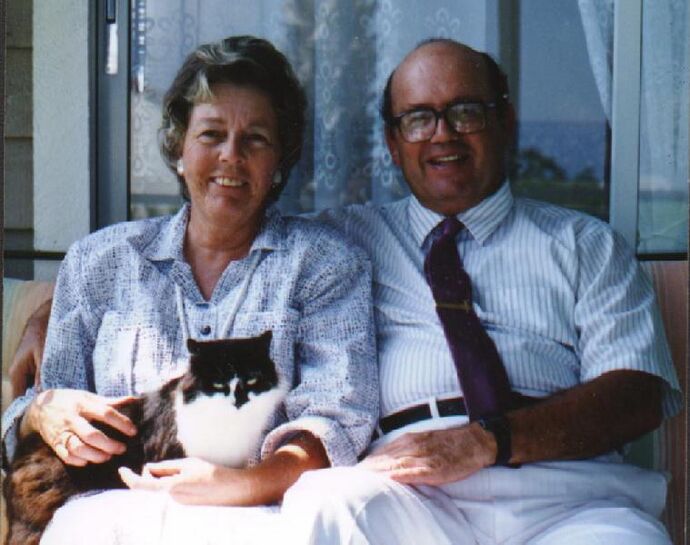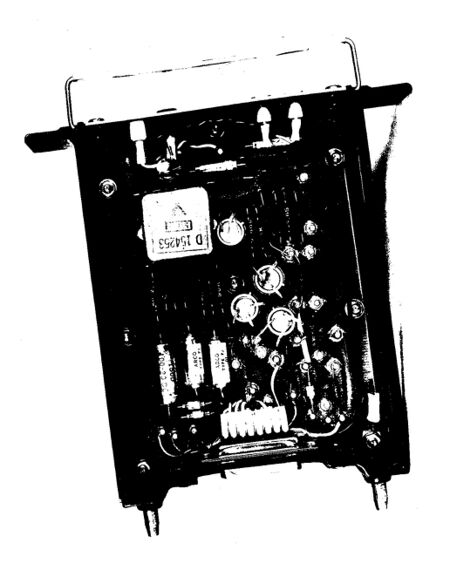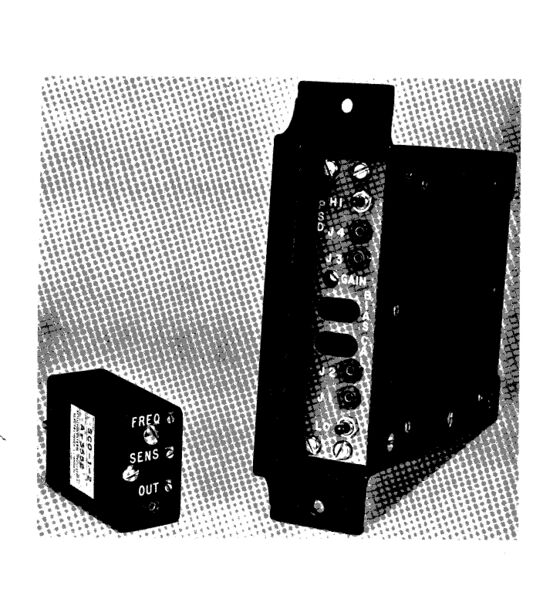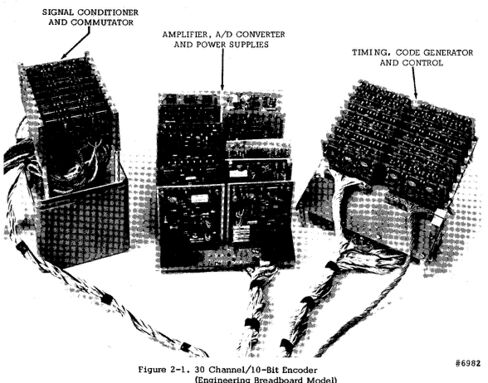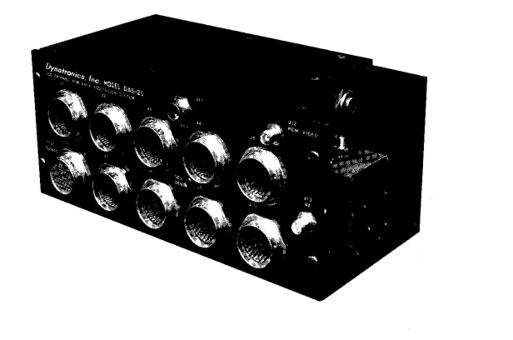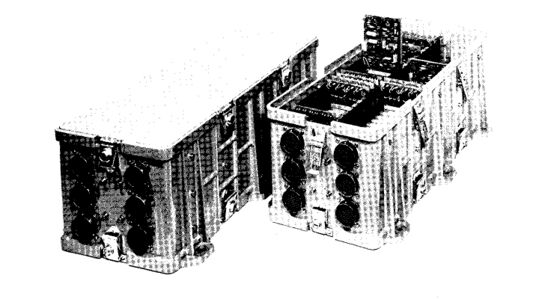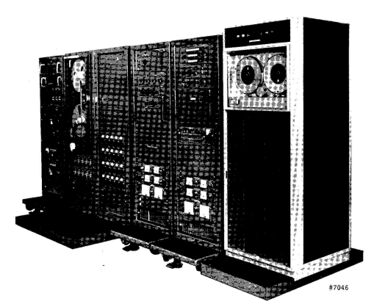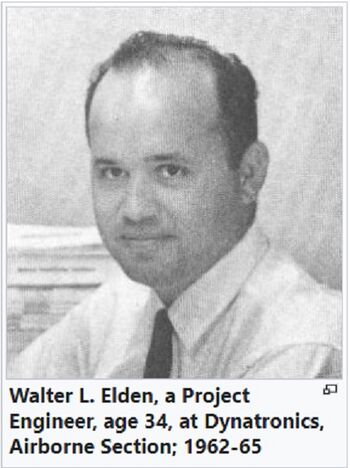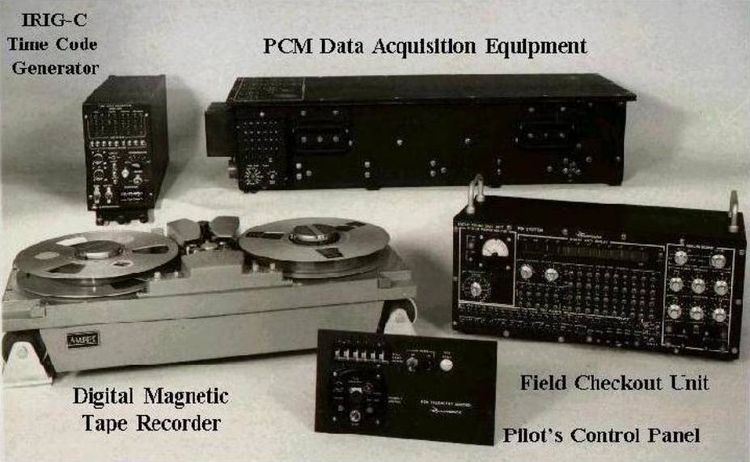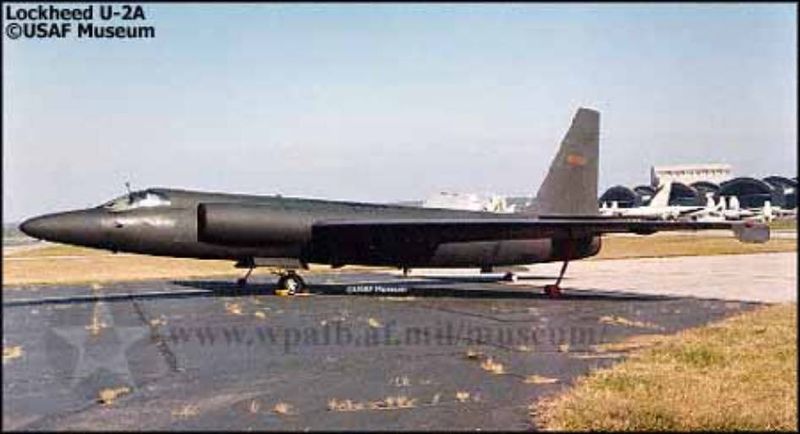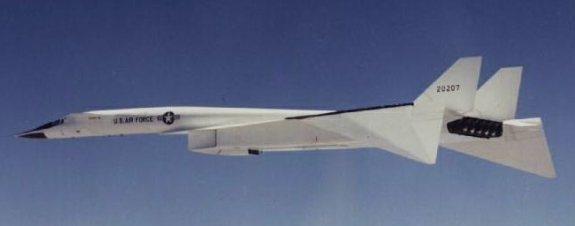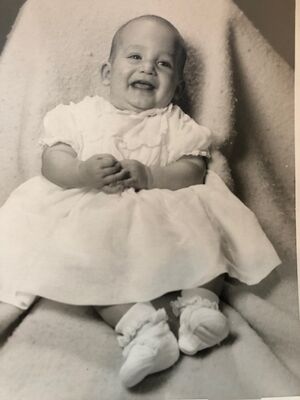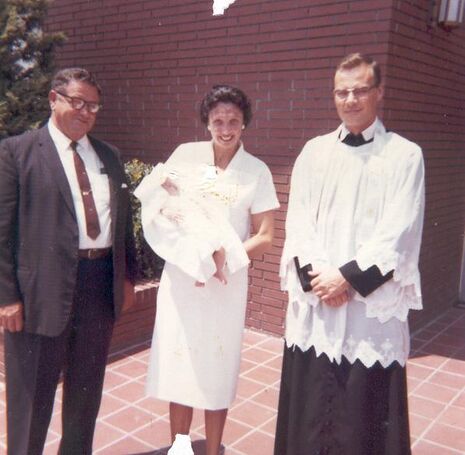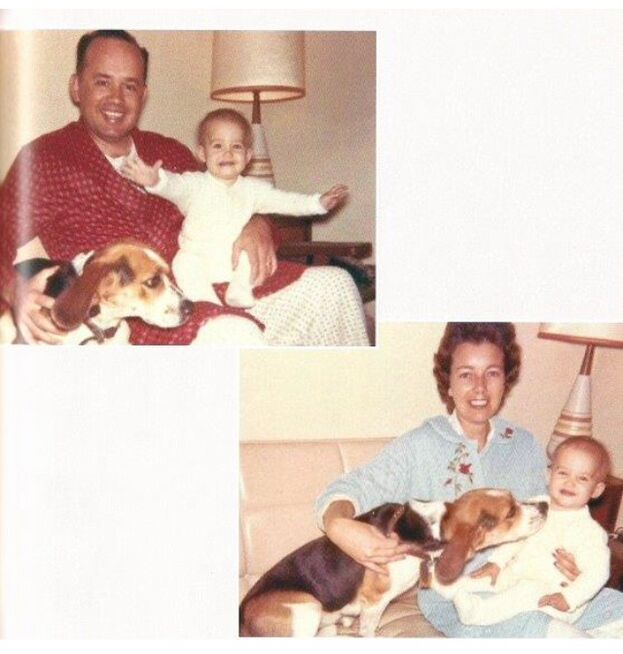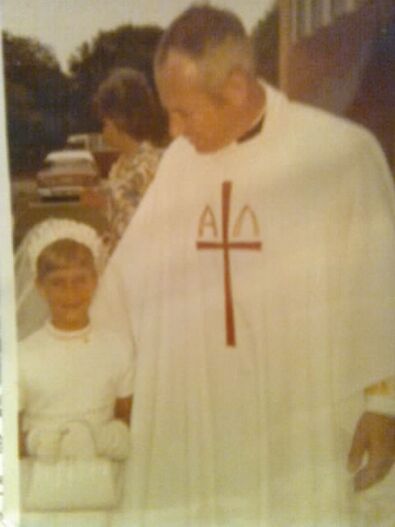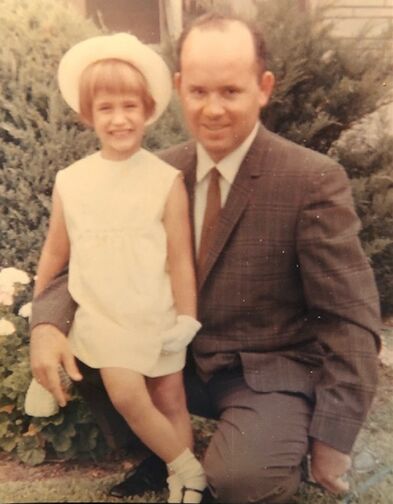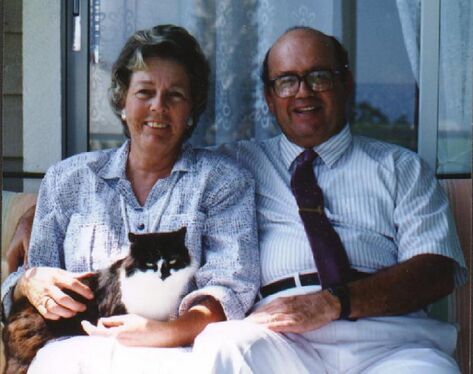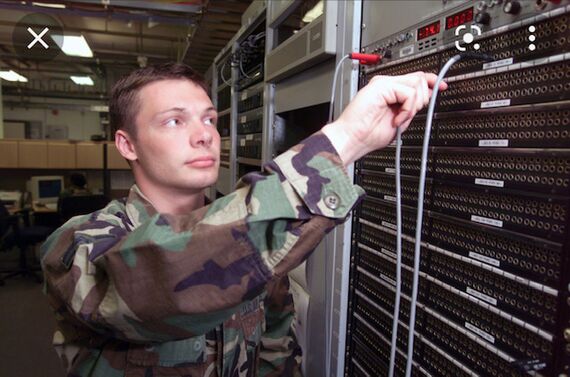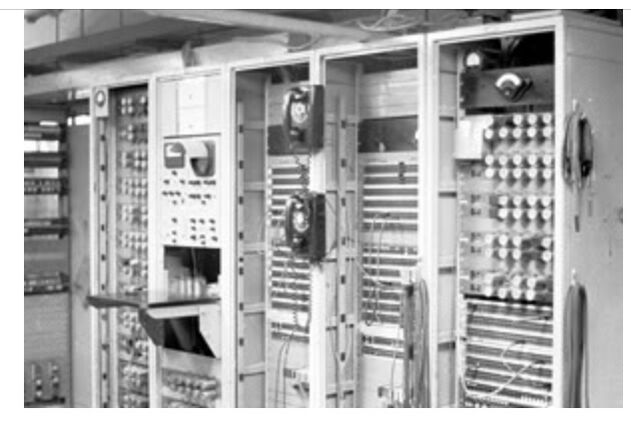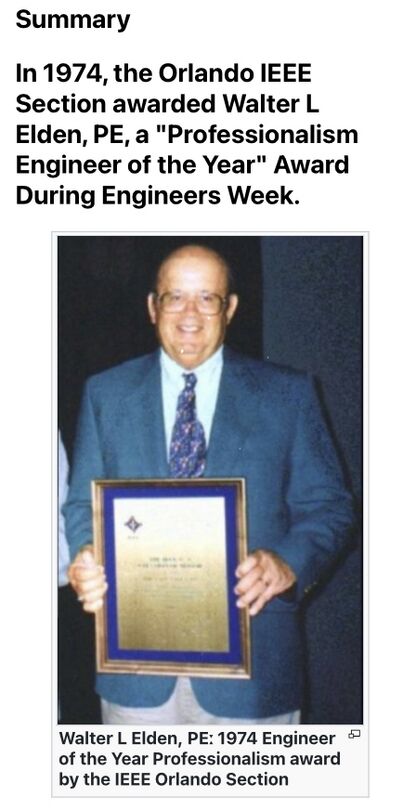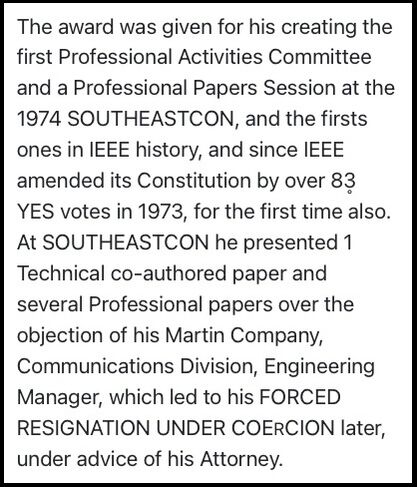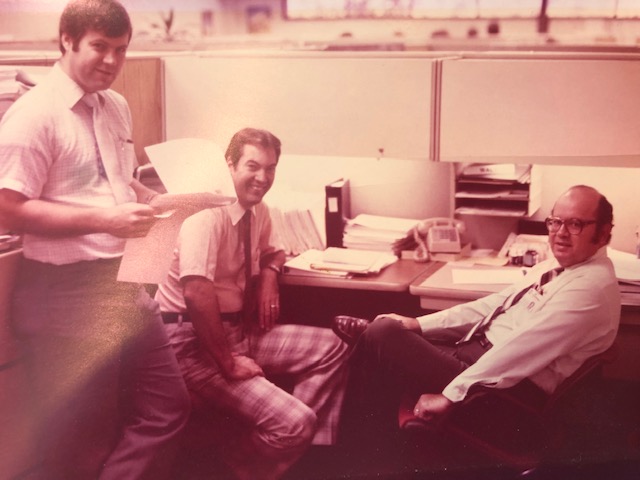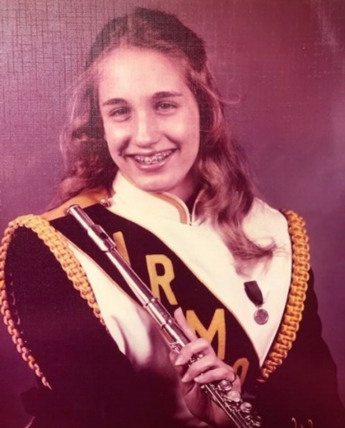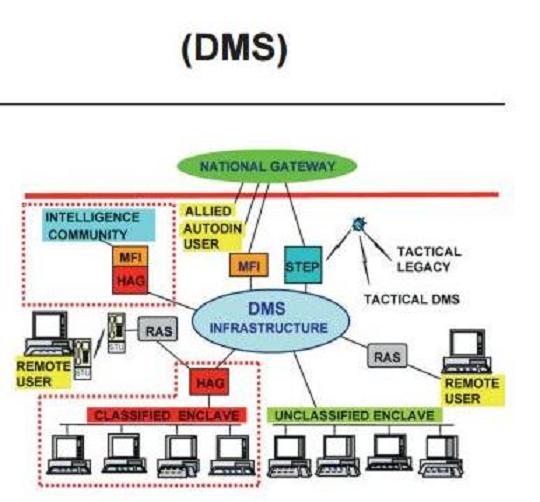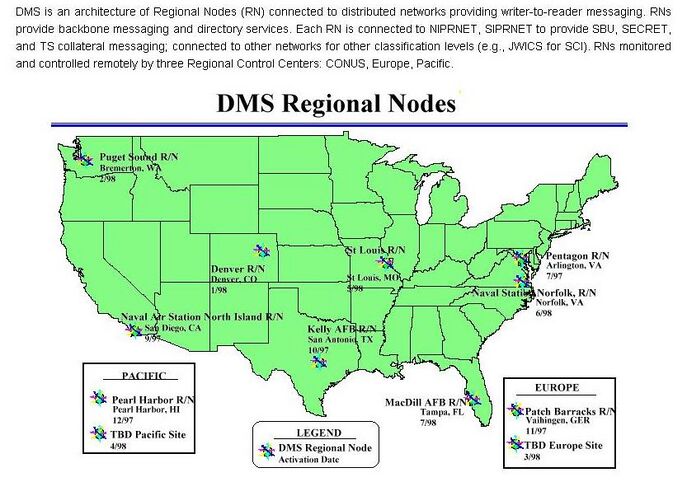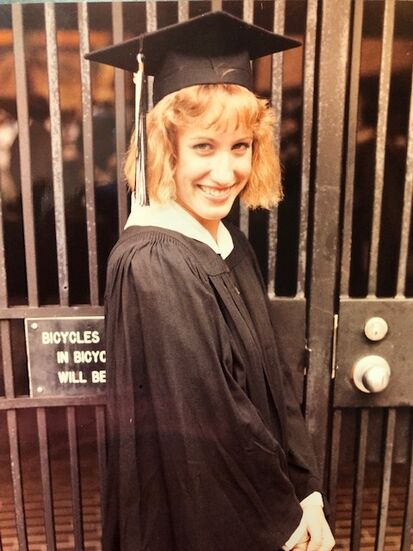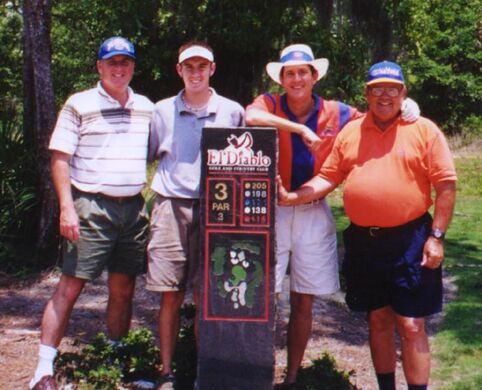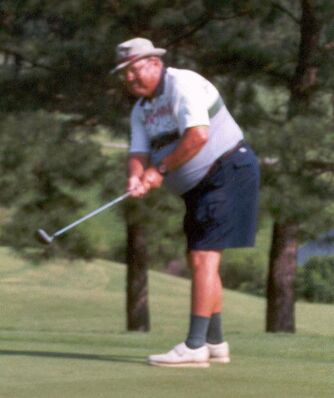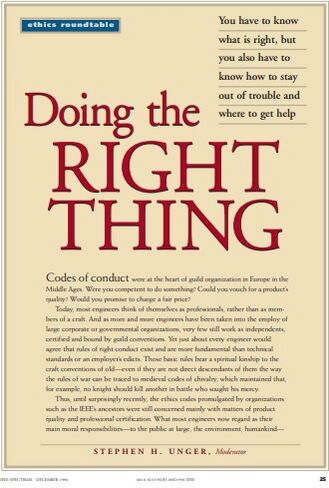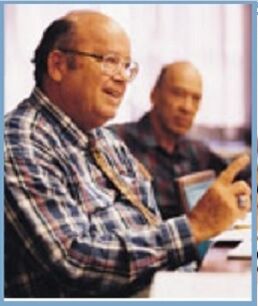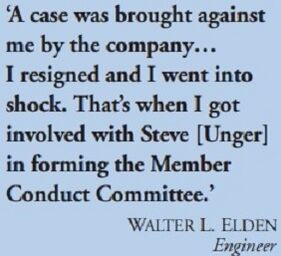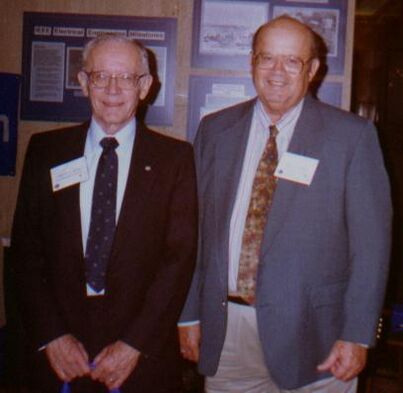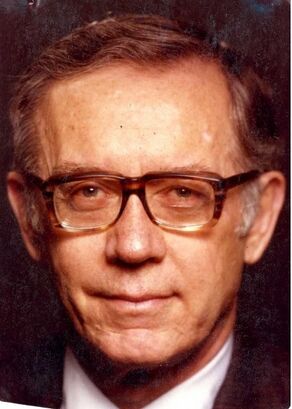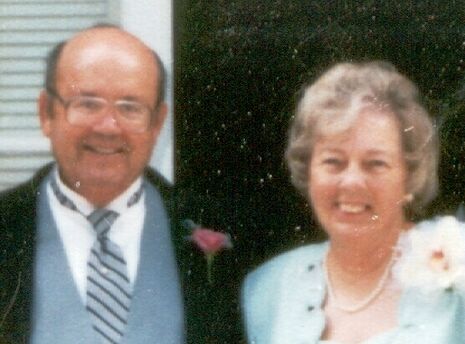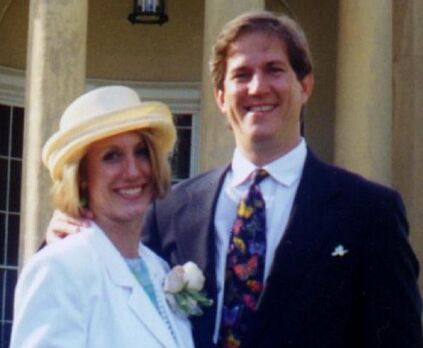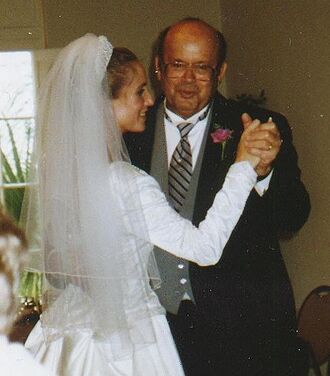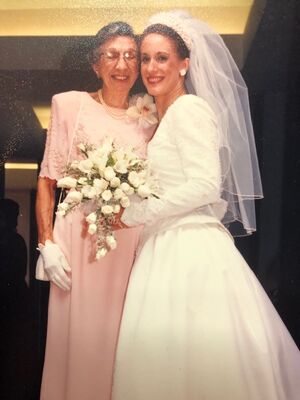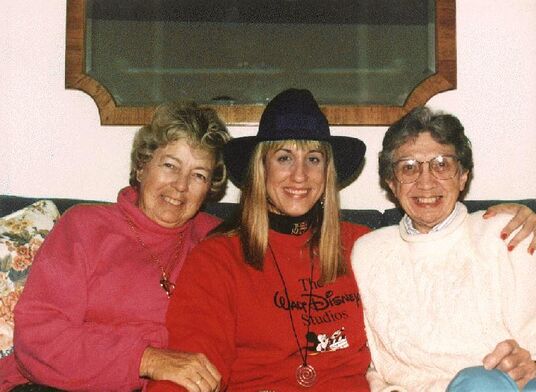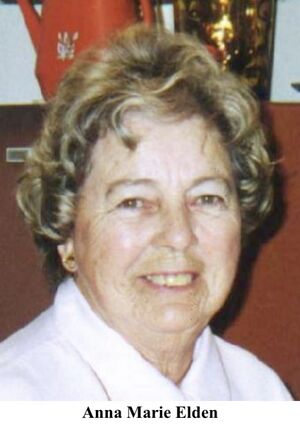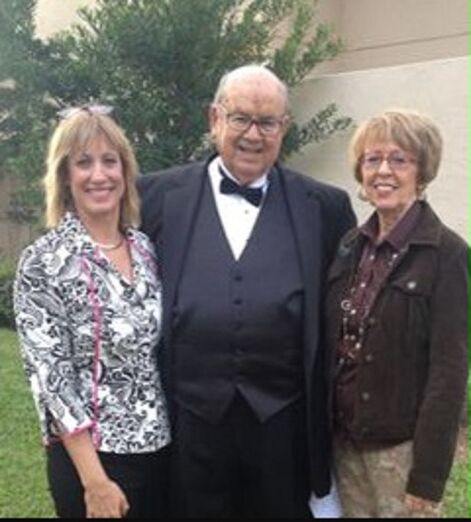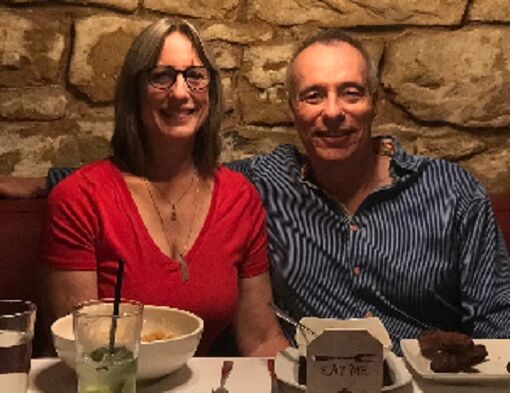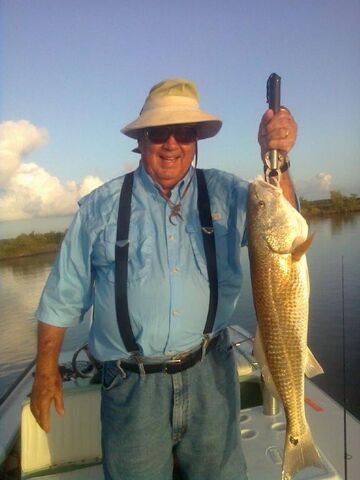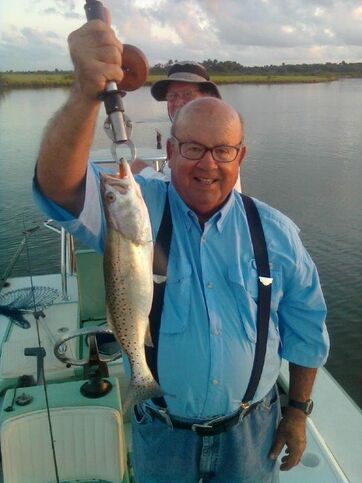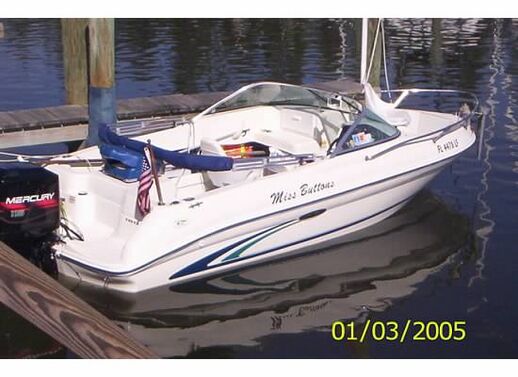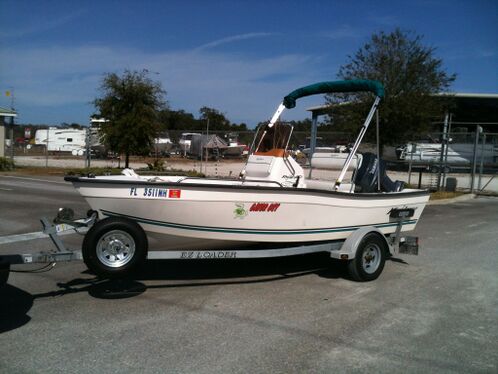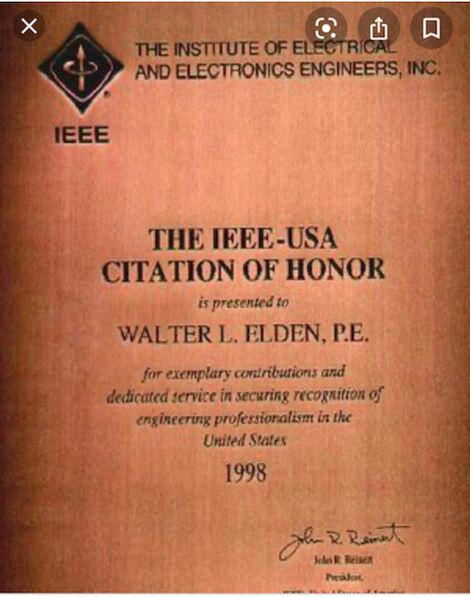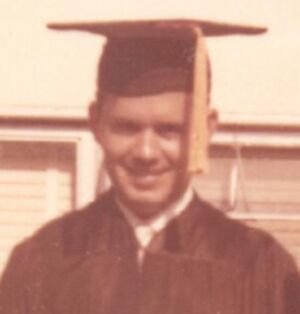Oral-History:Walter Elden
NOTICE TO READERː This is still under construction and is not complete. NOTICE TO READER
AUDIO, WRITTEN AND GRAPHIC ILLUSTRATIONS OF THE "PROFESSIONALISM, ETHICS AND LIFE HISTORY INTERVIEW" OF WALTER L ELDEN, PE (RET FL-97)
GO TO THIS LINK TO VIEW First-Hand: My Growing Up Pre-Engineer Years' Birth thru High School History
PRELUDE
My history, here in, through the application of using multi-media forms of telling my history, such as Written, Audio Voice Recordings and numerous Photo and Graphic Figures, are used to tell stories which occurred in my life. Starting with early growing up, became educated, became skilled in several forms of performing music, (with the goal aimed to become a Conductor of Orchestra, Mixed Chorus and/or Band). But then, the Korean War, starting 3 weeks after graduating from High School in 1950, changed most of that, but for the better.
The positive aspect of serving in the Aviation Branch of the Navy, over 4 years, was both the electronic training and hands on experience I received maintaining 3 major equipment in my assigned squadron. That experience caused me to switch from a career in Music Conducting to that of becoming an engineer, designing and then becoming very active in promoting Professionalism and Ethics in engineering practice. Along the way, I was fortunate to have known some excellent colleagues during my practice. See next.
INTRODUCTION
Kathy Pretz, Chief Editor of IEEE’s INSTITUTE, conducted a raw interview of IEEE Life Senior Member Walter L. Elden, P.E. (RET) on April 23, 2021, to prepare for a 06 July 2021 article in IEEE's Institute. The subject matter focused on his views and past experiences in Professionalism and Ethics. Subsequent to that, he created Audio # 12 and then # 11, which are included in the Introductory portion of this Captured Oral History below.
A-Passionate-Proponent-of-Professional-Ethics-for-Engineers
Walter Elden has been an advocate for ethics advice and support programs for members since he led the USAB proposals for creating the original IEEE MEMBER CONDUCT COMMITTEE in 1978, THEN SERVED ON IT 1996-1998, AS ADVOCATE FOE ETHICS ADVICE AND SUPPORT. He then created and led the IEEE CONCERNED ETHICS VOLUNTEERS, the CEV, to restore Advice and Support, which was restored in 2022.
MY EDITORIAL REMARKS
To fully understand why I, Walter Elden, have devoted so much of my IEEE Retirement years to promoting engineering Professionalism and Ethical Support to IEEE Members, go to this link and read IEEE's history of supporting Members for 20 years, then for the next 20̟ years, not supporting them and the laws which help and hinder supporting them.
First-HandːWhy IEEE Members Need Ethics Advice and Ethical Support-Walter Elden
ADDED AUDIO # 12 - IMPORTANT "FUTURE ISSUES NEEDING DISCUSSED"
GO TO THIS LINK TO HEAR WALTER'S RESPONSE TO THIS QUESTIONː
- Audio File
- MP3 Audio
(Elden OH - Interview ADDED ITEM Number 12.mp3)
ADDED AUDIO #11- IMPORTANT "NON-WIN, NON-WIN" ETHICS Cases; NASA, VW, BOEINGː
====
- Audio File
- MP3 Audio
(Elden OH - Interview ADDED ITEM Number 11.mp3)
====
Here is the link to the published article in the JULY 06, 2021 INSTITUTE ː
SUGGESTIONː Listen to each audio while following the original unedited text, as in the audios, new comments of Elden have been added. Answers to 5,6,9 and 11 are particularly important. But is is recommended to start listening to Audio # 11 first, as it sets the foundation for why Walter has been so devoted advocating for IEEE's Ethical Advice and Support for its members.
QUESTION 1. TELL ME ABOUT YOUR ENGINEERING CAREER STARTING RIGHT AFTER GRADUATING FROM HIGH SCHOOL.
GO TO THIS LINK TO HEAR WALTER'S RESPONSE TO THIS QUESTIONː
- Audio File
- MP3 Audio
(Elden OH - Interview Question Number 1.mp3)
THIS IS INTERVIEW QUESTION NO. 1
THREE WEEKS AFTER GRADUATING FROM HIGH SCHOOL, THE KOREAN WAR BEGAN, JUNE 1950
FIRST, I NEEDED TO FIND A SUMMER JOB TO EARN MONEY TO ATTEND THE U. OF MIAMI
The Korean War at that time felt thousands and thousands of miles away from me, so I began preparing myself to become educated and trained for a Musical Conducting career. And with the Musical Scholarship I had, it became my financial foundation to attend college at the U of Miami, across town. At the time, I had a part time job as a grocery Bag Boy, earing tips for bagging and carrying out groceries to people's cars on Friday evenings and all days Saturdays. Now, if I could only get full time employment, I would be able to save money to buy a car and to upgrade my violin. Well, that is exactly how the summer worked out for me in my favor. Further, I’d hoped to keep dating Jane Berry, my high school sweetheart. But once we each got settled in our respective course work , we drifted apart until around 2006 we got back together, but then Jane passed away.
NEXT, I NEEDED TO SAVE ENOUGH MONEY
Well, this worked out for me too. I obtained a full time job at the local large grocery store as a Bag Boy and Stock Clerk. Near the end of summer, through careful budgeted saving, I was able to buy my first car; a 1939 Dodge 2 door coupe. It fit my needs perfectly.
1939 Dodge 2 Door Coupe, Walt's 1st Car
Next, I upgraded my violin in 1950 at a cost of 150 dollars. In 2015 it was valued at 3000 dollars. In 2025 it will be 100 years old and I will have had it for 75 years.
THE UPGRADED 1925 GERMAN BUILT VIOLIN I PURCHASED IN 1950 TO BEGIN STUDYING TO BECOME A MUSIC CONDUCTOR
At the University of Miami in my Freshman Year, I studied a variety of Music Theory and violin courses, played the violin in the U o Miami Symphony and sang Bass in the Mixed Chorus. As the U of Miami Symphony was the only orchestra in Miami, and contained professionals in addition to its students, we obtained the First Line soloist artists from New York and served as Miami’s home orchestra.
At one concert, our guest artist was world renowned violinist, 50 year old Joshua Heifetz, performing Beethoven’s Violin Concerto NO. 1. During a break I went up to him and he signed his autograph on the inside of the Concert Program. I still have it today.
Some 60 years later, during a break in rehearsal of the Daytona State College Symphony I played in, the Conductor was talking with our 2 First Violinists Chairs’ about the same Joshua Heifetz. At a convenient break in their conversation, I took out the signed autograph of Heifetz from my violin case, showed it to the 3, and each one almost fainted from surprise and disbelief. I enjoyed that moment.
EXAMPLE MUSICAL ORGANIZATIONS WALTER PERFORMED IN AT THE U OF MIAMI
A U OF MIAMI SYMPHONY ORCHESTRA
A LINK TO AN EXAMPLE OF MUSICAL WE PERFORMED IN THE ORCHESTRAː
A U OF MIAMI MIXED CHORALE
LINK TO AN EXAMPLE PERFORMANCE OF HANDEL'S HALLELUIA CHORUS FROM THE "MESSIAH" WHICH THE U OF MIAMI MIXED CHORUS PERFORMED DOWNTOWN MIAMI, DECEMBER 1950ː
THE EFFECTS OF THE KOREAN WAR CLOSED IN UPON ME.
g. I was given an intelligence test and was told that I did well enough that I would serve in the Aviation Branch plus be guaranteed to attend 33 weeks of aviation electronics maintenance. This was intense instruction in electronics theory and hands-on maintenance and trouble-shooting of real military equipment we would experience once assigned to an Aviation Squadron. At the end of each week we were given a test. At the end of the 28 weeks training our grade point standing in the 100 person class determined what our next duty station would be. I chose the Sanford Naval Air Station, near Orlando in Florida, then later was transferred into Squadron VX-1, in Key West, FL, an ANTI-SUBMARINE DEVELOPMENT SQUADRON.
h. It was the effects of the Korean War which gave me the opportunity to pursue engineering rather than music
i. I eventually received a year of schooling and was trained in Naval Aviation electronics, and SONAR
j. I spent most of my 4 year Navy career in Airborne Squadron VX-1, which was devoted to Anti-Submarine Warfare Development, as an Aviation Electronics Technician. In this capacity, I maintained all of the squadron's IFF, Loran and Radar Altimeter equipments on a variety of aircraft (TBF Torpedo Bomber, B-17 Bomber, Corsair, P2V, jets and Blimps). Three of the newest Grumman S-2F twin-engine anti-submarine hunter-killer prototype planes were flight tested in his squad
I was honored to be able to perform the violin at mid-night Christmas Mass and conduct a small choir at some services.
k. I Assisted a Field Engineer install and test the new APN-22 Radar Altimeter in planes and blimps of our squadron
l. That experience convinced me to switch to engineering from music and to become educated to design the equipment rather than just test and maintain them as a Technician
ADDITIONAL ELECTRONICS STUDY I DID IN THE NAVY
Before leaving the Navy, I took advantage of their free educational self-taught technical course work. As a result I studied both FM Radio and Television electronics. To put my knowledge to a test, I found and purchased a damaged complete Audio, AM/FM Receiver with as 12 inch Tube TV Console, for 10 dollars at an electronics warehouse. I only had to replace the 12-inch CRT Picture Tube for an additional 25 dollars and I did that work on my free time in our electronics shop in the Navy. Being only 90 miles North of Havana, Cuba, I erected a TV Antena outside our shop and we watched live TV Broadcasts direct from Havana. Later, I presented this complete console to my parents as their first ever TV set. That entire effort was very gratifying.
Nashville and The Grand Ole Opry Country and Western Music
While in airborne electronics training in Memphis, TN, once a month, I would travel to Nashville for the weekend to visit former classmate, Robert Sherrill. He was attending a Christain college there. We arranged it so that we would get to attend the All Night Sing on Friday nights and then the Grand Ole Opry the next night, Saturdays, performed in the original Ryman Auditorium, to hear first, good gospel singing and then great Country and Western music and singing. Nashville, as you know is the center of Country and Western music. If you recall, my high school band Director J. Howard Reynolds introduced me to Country and Western music when he demonstrated the first High Fidelity music system to me in his home; beleive it or not, to this day, I still enjoy it. The music is great and you can understand the lyrics.
When I Built My First High Fidelity Audio Music System
During my service in the Navy, I began to apply two things I had picked up along the way, to augment that fact that I was no longer pursuing a music performing career. When I was stationed outside of Memphis, TN, at the Millikan Naval Air Station, I attended 28 weeks of electronics school. Early on, I used to go into Memphis on weekends and I found where the new 33 1/3 rpm record players were being sold. I bought one, took it home, and with my new knowlege in electronics, began to merge that knowledge with my love of music. I found a way to hook up the Long Playing record player to my parents radio system at home, resulting in my first attempt at creating a high fidelity system, somewhat like what my high school band director, J. Howard Reynolds, had showed me of his at his home.
This also began my monthly purchasing of LP recordings, which was the start of a new record collection of classical music. Then, as I would get moved to new duty stations, I would eventually end up in the Post Exchange, looking for and buying more LPs recordings, adding them to my collection. At that time, a company named Heath, located in Benton Harbor, MI, sold all kinds of electronic building kits. I bought one and built my first high fidelity all vacuum tube amplifier system. Later, I purchased a kit and assembled a large 12 INCH TRI-AXIAL bass reflex speaker enclosure system. Playing a LP player through the amplifier connected to the speaker gave me a true high-fidelity system, one I would have been pleased to match against my former band Directors'. Thus, I was finally able to marry my newly acquired knowledge of electronics with my continued love of music. Wonderful. It all fit. Later I moved it all to my room at the University of Florida. I even assembled and added an AM Radio Receiver to it.
MY FIRST-SELF BUILT HIGH FIDELITY SYSTEM
THE IMPACT OF MY FIRST VISIT TO THE UNIVERSITY OF FLORIDA COLLEGE OF ENGINEERING 1954
a. In 1954, I Visited the campus of U of Florida while serving in the Navy, where I spoke with a professor about the school of Engineering, I was impressed by what I saw and learned, then enrolled at the University of Florida, THE GATORS.
b. Being a Korean War Veteran of the US Navy, the GI Bill paid for my education and living expenses
ACTIVITIES WALTER ENGAGED IN AT THE UNIVERSITY OF FLORIDA 1955-1958
After my discharge from the Navy in May of 1955, I enrolled at the University of Florida and pursued getting a degree in electrical engineering. I started that summer and thereafter attended classes year-round. With credits from my first year at the University of Miami, I was able to graduate in 3 years (With Honors). This is how I accomplished that featː
After my discharge in May of 1955, I enrolled in a summer School session immediately and delved right into a Math class and one other course. After that I attended classes year round for the next 3 years. I would take 5 classes in the Fall the 4 in the Spring, then back into summer school.
Involvement with Performing Vocal and Orchestra Music During College and a Member of the Bass Section of Vocalists, in the 3 Verdi Requiem performances
During my second, or Junior year, I joined the A Capella Choir, under the direction of Clem Boatwright. A Capella means without accompaniment. An innovation of Director Boatwright was that he seated us in groups of fours; a soprano, an alto, a tenor and a bass. This enabled us to hear the harmony of parts better, I believe. We performed concerts on campus, out in the nearby communities at schools, and at a large church in Jacksonville.
During the Spring of 1957, a very large mixed chorus was formed on campus. It was created to learn and perform the all-powerful Verdi Requiem. This was quite an experience. I have never heard that requiem performed before so as we were practicing it, the beauty of the music, solos and choruses just overwhelmed me. Then came time for the actual concert performance(s), and there were several. First, as we had two sets of soloists, we performed the Requiem on two consecutive nights, with the University of Florida Symphony. The challenge was the best set of soloists from that series, would then get to go with the ensemble down to Miami where we performed it again before a Music Convention held there. We took the full chorus, soloists and symphony orchestra and travelled by Greyhound buses to and from Miami. In one part of the work there is a part whereby an offstage brass choir plays and is answered by the onstage brass. This goes on back and forth and builds until finally the fully orchestra and chorus joined in. It was very exciting. This work is more like an opera than a requiem. A photo shows the complete ensemble as it was assembled on one of the evening performances at the University. During the performance in Miami, I looked out and saw my long time Violin teacher, Lace Coe, sitting there.
University of Florida Chorus, Orchestra, Soloists Performing the Verdi Requiem, 1957 (Walter is located 8th in from the Right, in the last row)
LINK TO A PERFORMANCE OF THE "DIES IRAE AND DOUBLE BRASS FANFARE' FROM VERDIE'S REQUIEM ː
BBC Prom 13 - Verdi Requiem - Dies Irae e Tuba Mirum
My Experience Playing Violin Again in the University of Florida Symphony Orchestra
In my senior year, I decided to return to my violin roots, so I switched from the A Capelle Choir and joined the symphony orchestra. I had to brush up on my violin as I had not played it in over 6 years. Some of the concerts we performed were at the nearby elementary schools around Gainesville, FL. But we had one real highlight program. This was an evening concert in the auditorium, wherein the program broadcast over the campus radio station, WRUF, on both AM and FM, "became the first stereo radio broadcast to occur in the state of Florida". That was in the year 1958. Then we performed at the January commencement and in the Spring, we performed with the Mixed Chorus Handel's oratorio, The Messiah. I had sung in choruses before performing that work, but that was the first time I had played in an orchestra accompanying a chorus singing it. In the late Winter of 1958, I began hearing of The Bach Festival Choir, in Orlando, Fl, but I was not able to go hear them perform. Buy better yet, the next year after moving to Orlando, FL to work at the Martin Co. I joined and sung in the Bach Festival Chorus.
U of Florida Symphony Orchestra I Played In; 1958
OOPSǃǃǃǃǃ I MUST HAVE MISPLACED MY BOWǃǃǃ
Click Link Next for a Sample Performance by the U of F Orchestra
University of Florida Playing "Voices of Spring"
IN 1958 WALTER GRADUATED FROM THE U OF F WITH A BEE WITH HONORS DEGREE IN 3 YEARS
WALTER WAS AWARDED THE GATOR GUARD 50 YEAR ALUMNI AWARD IN 2008
50 years after Walter received his BEE degree from the U of Florida, in 2008 he was inducted into the Florida Alumni Association's "50 YEAR GRADUATES GATOR GUARD"; WITNESSED BY HIS 2nd WIFE KAREN, PhD, AND DAUGHTER MARIANNE, MS.
KAREN, WALTER, MARIANNE and U of F 50 YEAR GATOR GUARD HONOR
-----------------------------------------------------------------------------------------------------------------------------------------------------------------
As taking these music classes were treated as electives courses, and I made "A's" in them, they helped my grade point average and in June 1958, I received my degree, a Bachelor in Electrical Engineering BEE (Communications Option), With Honors, in 3 years.
In order to have been able to do that in that short a time, I had to go to school year-round, use credits from my Freshman year at the U of Miami, and take both the first and second half of a Physics course at the same time. Don't ever try to do that yourself. It was real tough, but I somehow made A's and B's in each of them.
MY PROFESSIONAL BELIEF OF WHAT IS A TOTAL ENGINEER IS
A. A TOTAL ENGINEER EQUALS THE SUM OF HIS/HER TECHNICAL AND PROFESSIONAL EXCELLENCE
I developed early in my career, because of the Professional and Ethics course taught to me at the University of Florida, the philosophy and believed that to become what I coined a Total Engineer, one must excel in both his/her Technical as well as Professional work. So at first I concentrated on performing my technical work as best as I could. But as time went on, I felt something was missing and I began to focus more on adding the professional aspects of engineering into my career practice. And the more that I placed emphasis on the Professional side, the more I encountered resistance both from my employers and well as in my activities in the IEEE. Therefore, before discussing the heart of this paper, I will set out the basis for my having become and accomplished Technical Engineer. After all, at that time, the IEEE's Constitution, only permitted it to engage in "Technical Activities". What follows initially, therefore, are highlights of my Technical resume. Throughout my career, of some 40 odd years, I was responsible for the Technical Designs of Products and Systems which ranged in value from a low of $ 100 Thousand to over $1 Billion.
At Florida, around 1956-57, I joined both the AIEE and the IRE Student Chapters, and have remained a Member ever since of their succeeding merger into today's IEEE, now nearly 60 years. One of the engineering courses I took, called Professionalism, Ethics, Economics and Safety, introduced me to the NSPE Code of Ethics and of becoming a Licensed Professional Engineer. It just so happened that our Engineering Dean, Dr. Joseph Weil, was the founders of the Florida Licensing Board of Professional Engineers, which led to the engineering students being informed about the professional side of their future practice, and that awareness, has stayed with me to this day. The most important outgrowth of this was that during the week of graduation, I had prepared, took and passed the then Engineer-in-Training (now call Engineer Intern) exam. This was the first step to becoming a Licensed P.E. later, once I had acquired 4 years of practice as an engineer.
I was particularly influenced by both the NSPE Code of Ethics and the Professional Engineering Licensing law. Together, they set the bar for what kind of responsible and competent engineer I wanted to become in my career and the image as a true "Professional" I hoped to garner from my career. Further, the proceedings of both the AIEE and IRE also had positive influences on me, in being able to see what my forefather engineers had set down on paper in professional/technical journals, presenting what the theory of my profession was all about. Collectively, these influences led me naturally to join the full membership in both IRE and the AIEE once I graduated and started practicing.
B. THE PROFESSIONAL RIGHTS OF ENGINEERS"
Ethical Rights & Responsibilities of Practicing Engineers
BY WALTER L. ELDEN, P.E., NIEE BOARD OF GOVERNORS, IEEE LIFE SENIOR MEMBER, MEMBER CONDUCT COMMITTEE
What rights do or should engineer employees have?
Within the context of an engineer employee (unlicensed as a Professional Engineer) working for an employer, what rights do engineer employees have, or should have, for each responsibility in Codes of Ethics? If this same engineer employee were a licensed/registered/chartered Professional Engineer in good standing, what additional or different rights would or should the engineer have?
Readers are invited to submit their views FOR or AGAINST the proposition that: A person, by virtue of practicing as an engineer and exercising the duties and responsibilities which go with such a professional position in employment, has certain rights, which should correspond with ethical responsibilities, when engaged in an engineer employee capacity.
Background on Individual Rights in the United States
On Dec. 20, 1787, Thomas Jefferson said the following when it became apparent that the new Declaration of Independence was flawed in that it lacked protections of individual rights:
A bill of rights is what the people are entitled to against every government on earth, general or particular, and what no just government should refuse.
Out of this climate came the Declaration of Independence, a blueprint for self-government by the new United States, with a strong executive branch, a representative legislature and a federal judiciary. But its flaw was that it lacked a specific declaration about individual rights, including the prohibition against slavery, which the country corrected much later at great human costs. The new Constitution specified what the government could do, but did not say what it could not do. Four years later, the United States adopted the American Bill of Rights which Jefferson inspired and James Monroe drafted. In 1791, the Bill of Rights, containing the first 10 amendments, became the law of the land.
The Bill of Rights was necessary to protect individuals from the perceived abuses that could result from the new government. This view was based upon the experience the British Americans had experienced under the rule of the British. As such, the founders of the nation=s AEs believed that containing the new government AEs power and protecting liberty was their most important task.
They declared a new purpose for government: the protection of individual rights.
Rights Today
At the time they formed the new government of the United States, the founding fathers viewed the new system as being the only threat to individual rights. They had no idea back then the amount of power corporations today would have, some of which exceeds government power. The America Civil Liberties Union (ACLU) has written that:
Today, most Americans are more vulnerable to having their rights violated by their employers than the early Americans were to having their rights violated by the government. Yet, because the Constitution does not limit their authority, private employers are freed to violate the civil liberties of their employees. Nationwide, the ACLU receives more complaints about abuses by employers than about abuses by the government.
What are Rights, Anyway?
One definition of a right is Aa justified constraint upon how others may act.@ AMoral philosophers have recognized that there is a close relationship between the duties we have toward others, and the rights others have relative to us.@ There is the concept of AMoral rights.@ i.e., Arights that are held to exist prior to, or independently of, any legal or institutional rules@. AMoral rights are entitlements to certain treatment that all people in a group have equally by virtue of the fact that each group member has a certain status.@. In the Bill of Rights to the U.S. Constitution, there is the phrase Ainalienable rights. What this means, according to Webster AEs Dictionary, are rights which cannot be transferred or surrendered. In 1948, the United Nations adopted the Universal Declaration of Human Rights to which all people are entitled. We understand this declaration less as a description of actual rights but more as a list of ideals to which we aspire.
Ethical Rights and Responsibilities of an Engineer
With this brief overview, what can we determine about rights corresponding with ethical responsibilities, which engineers have or should have, when engaged as employees? This is the topic that an Aethics rights@ discussion mail list addresses. The WEB address for this is: www5.palmnet.net/~welden/maillist/rights/eth-righ.html
Members can provide their views, pro or con, on this subject. We created this mail list to foster discussion and contributions aimed at creating a document titled AA Declaration of an Engineer's Rights and Responsibilities@ with the IEEE Code of Ethics as a basis, among other considerations, such as protecting the public, consulting, employment and other factors. Supporting the mail list is a companion Ethics Rights and Responsibilities page. To view the messages posted already, view the archives at: www5.palmnet.net/~welden/maillist/rights/righ_msg.html
Comments may be submitted to the author at w.elden@ieee.org(link sends e-mail)
C. MY 1st ENGINEERING EMPLOYMENT-THE MARTIN CO, ORLANDO, FL 1958-60
During My Earliest Years I Was a Systems and a Product Design Engineer
From 1958 through 1960, right out of college, I was the System Engineer with the Martin Company, in Orlando, Florida, responsible for specifying and over seeing 2 contractors develop the Telemetry Signal Conditioning equipment flown in testing the development of the US Army's new solid propellant Pershing Missile. Then from 1960 to 1965, I performed and also responsible for the design and development of Telemetry and Data Acquisition equipment for Airborne and Aerospace applications (high altitude research ballons, aircraft and missiles). I both worked independently and led design groups as a Project Engineer, with total responsibility. All of these equipment had to not only perform to performance specs but also operate while doing so in extreme environments. Initially these equipment were implemented using analog technology but later transitioned to digital through the use of discrete transistors and later integrated circuits. All of this work was done on fixed priced contracts, which we had to bid on to win the work. We created State-of-the-Art products.
My first assignment as an Engineer was with the Martin Co, in Orlando, Fl with a Systems Engineering assignment where I was responsible for specifying requirements, selecting 2 subcontractors, and then overseeing the development by subcontractors, (Dresser Electronics of Houston, Texas and Texas Instruments of Dallas, Texas) to develop a suite of Signal Conditioning modules of various real time vehicle measurements for flight testing the Army’s new Solid Propellant Pershing Short Range missile. Each Pershing tested carried 80 of these Modules in 8 Racks.
On one occasion, my Supervisor, Walt Hane, and I were tasked to go over to Cape Canaveral to test a noise condition reported to be in this equipment. As shown in the figure, our Telemetry equipment was located half-way up the Pershing missile in a black colored section.
We each accessed our modules; he from one side and I from the other. We needed to get our upper bodies inside the compartment, from waist and arms upward.
Without any warning, another missile nearby was launched. Knowing ours may have been loaded with its Solid Propellant Rocket motor, and with both the noise that nearby missile and vibration made, we looked up across at each other believing we were going to go into space. Of course, that did not happen. But it scared the xyxy out of the both of us.
e. Later, once the Army Pershing Missiles were deployed along the Eastern Front of Europe, Nuclear Tipped, to hold the Russians back from invading Europe.
D. MY CONTINUED PARTICIPATION IN MUSIC
Once I got settled in my new jog at the Martin Co I applied and was admitted into the Bach Festival Choir of Winter Park; only 1 of 4 across the United States. Our Director of Engineering of the Pershing Missile Project, John Goodlette, also was a member, singing Tenor.
THE BACH FESTIVAL CHOIR AT ROLLINS COLLEGE, WINTER PARK, Fl
Click Link Next to Listen to the Bach Festival Choir Sampleː
E. IT WAS AT THE MARTIN CO WHERE I MET MY 1ST WIFE, ANNA MARIE WALSH
Anne was employed as the Administrative Assistant, or Secretary then, to the Finance Director of the Army’s Pershing Project. I had another Secretary introduce us and after dating for about 6 months we married. We each were Catholics. I sold the Mobile Hime I had lived in for the previous 3 1/2 years and bought our first home. She had an inherent skill for investing in stocks and for finding appreciating real estate which we invested in. Later in her life there developed medical problems in her Heart and Liver, which later in 2005 were the causes of her passing. We later adopted a baby girl, and named her Marianne Alice.
2. MY 2nd ENGINEERING EMPLOYMENT WAS WITH DRESSER ELECTRONICS, HOUSTON, TX 1960-62
f. After working 2 years at the Martin Co. I decided that I needed to get actual experience designing and developing various electronics equipment.
g. So I moved to Houston, TX with one of my Sub Contractors for the Pershing program, Dresser Electronics.
There I was assigned and developed one of the Signal Conditioning Modules used to test the new Air Force ICBM Missiles, the Minuteman.
Product Development at Dresser Electronics 1960-1962
Beginning in 1960 I moved to one of the companies, Dresser Electronics in Houston, Texas, which had developed some of the above Signal Conditioning modules for the Pershing. I made this move to gain product design experience, as opposed to the systems engineering work I had just done at Martin. There at Dresser, I designed one of the Signal Conditional modules which made up the overall equipment flown in the Titan II ICBM, for the Martin Company in Denver, Colorado, and for the US Air Force.
h. I took advantage of nearby U of Houston, enrolled and obtained MSEE degree, attending night school classes.
-------------------------------------------------------------------------------------------------------------------------------------------------------------------
3. MY 3rd ENGINEERING EMPLOYMENT WAS WITH DYNATRONICS, INC, ORLANDO, FL 1962-65
i. Then I moved back to Orlando, FL, where a new, small Ground and Airborne developer of Telemetry Systems and Equipment, Dynatronics, hired me into their Airborne Section.
At Dynatronics, in Orlando, Fl, I was in the Airborne Section, where we bid competitively to develop and manufacture state-of-the-art custom Telemetry and Data Acquisition equipment. I was a Project Engineer with total responsibility for technical, cost and schedule for work assigned to me, along with the direction of the team of engineers, technicians, draftsmen and planners who worked under my direction.
The products produced were used in High Altitude Research Balloons, Fighter Aircraft, Multi-Staged Satellite Launch Missiles and High Altitude Research Aircraft.
j. There at Dynatronics, I was a Project Engineer with total responsibility for the proposal writing to compete, then after winning the contract, leading and doing the design, development, final testing and shipping to customers telemetry and data acquisition equipment.
My final and largest project which I led was for a 40 Channel Data Acquisition system for flight testing High Altitude Clear Air Turbulence, or HICAT, flown in an Air Force U-2 Research Aircraft. I delivered it to Lockheed Burbank, trained them and then assisted and witnessed the first test flight in a U-2 at Edwards Air Force Base. Later, the system was flown all around the world for 2 years, testing HICAT.
These for testing in High Altitude Research Balloons for the Air Force, Amplifiers for the F-4 Air Force Fighter, A 250 Channel System for testing the West German 2nd Stage Satellite Launcher.
The Super Sonic Transport, or SST, for which HICAT was developed and gathered high altitude turbulence data.
While Employed by Dynatronics, Anne and I were able to adopt our daughter, Marianne Alice, in 1963, and guide her development
OUR DAUGHTER MARIANNE JUST BROUGHT HOME FOR THE 1ST TIME TO BE ADOPTED
MARIANNE JUST BAPTIZED CATHOLIC
WALTER AND ANNE WITH MARIANNE AND BUTCH
MARIANNE JUST RECEIVED HER FIRST HOLY COMMUNION
YOUNG MARIANNE WITH DAD WALTER 1967
ANNE, WALTER AND PET CAT
4. MY 4th ENGINEERING ASSIGNMENT WAS WITH THE MARTIN CO, ORLANDO, FL - A 2nd TIME- 1965-67
k. I rejoined Martin Co in 1966 where I switched back to Systems Engineering for the remainder of my career. At Martin I was engaged in conducting studies, conducting research on new communications technologies, and had one work proposed for a Patent on Voice Encoding.
My Transition from a Product to a System Engineer
In 1965 I left Dynatronics to work again at The Martin Company, then re-named Martin Marietta. I was convinced during my interview, by a more senior and experienced system engineer, that it would be a better career move for me, which I followed. For the remainder of my career, I worked in what some called, Advanced Programs, as a Systems Engineer. All of these programs were aimed at developing and bringing in new business and focused on the bigger, total system, perspective. We were challenged to develop new solutions using state-of-the-art and sometimes new technologies and approaches.
Here, below, I highlight the several companies I worked for, and the new business systems I was involved with.
Martin Marietta, Orlando, FL 1965 - 1968
- US Army Time Division Multiplexer Voice/Data Sharing for Forward Field Observers
- Extremal Detector for Voice Encoding
- ATAC Army Tactical Area Communications System
- Automation of Technical Control Systems
5. MY 5th ENGINEERING ASSIGNME T WAS WITH HONEYWELL COMMUNICATIONS DIVISION, ST PETERSBURG, FL 1967-70
l. Then I moved to Honeywell in St. Petersburg, Fl, in 1968 where I continued my work and interest in Systems Engineering, wrote proposals, conducted studies, and won a Systems Contract for Automating the Air Forces Technical Control Systems for Communications. This contract involved a one week visit to the Air Force’s communications systems in the Tokyo, Japan area.
Honeywell Communications Division, St.Petersburg, FL1968 - 1972
- ATACS Automating Air Force Technical Control Systems Study
- McNamarra Electronic Battlefield Detection System
AIR FORCE MANUAL TECHNICAL CONTROL PATCH CORDS
OLD MANUAL AIR FORCE COMMUNICATIONS PATCH PANEL 1969
WHEN I WAS LAYED OFF FROM PRESSURE EXERTED UPON MY EMPLOYER, BY THE SUPERITENDENT OF THE COUNTY SCHOOL BOARD (1971)
In 1970, when I was employed by the Honeywell Communications Division, in Clearwater, FL, I was the Project Engineer who wrote the winning proposal that was selected by the US Air Force to study and recommend upgrading their worldwide Communications Technical Control Centers. Once we were awarded the contract, I was assigned as one of the Systems Engineers to execute it. Part of it was a one-week trip, for 3 of us, to the 5th Air Force Headquarters in Tokyo, Japan to visit its major communications sites around Tokyo to learn first-hand what needed upgrading.
During this trip, back home in Clearwater, FL, we learned upon our return, that the County School Board had announced that Cross Bussing of Elementary school children between Black and White schools, to achieve integration, would be put into effect. At the time the 3 of us were still in Japan, unaware of this and that it was the result of a Federal court order.
As our young daughter was only in the 1st grade, we were concerned about her safety, being bussed out of our neighborhood into another one, miles away. Apparently both Black and White parents in our larger community felt the same way, as we learned upon returning from Japan, that they had formed an organization to object to the School Board about this. Each of the 3 of us who made the site visit to Japan felt the same way and became involved in the new organization.
One of the 3 of us became the organization’s President, while I served as its Public Relations Spokesman. This community organization then voted to file suit against the School Board, to reverse its plan for Cross Bussing. This led us to begin attending meetings of the School Board and weekly meetings of a large Committee of the Board for parents and school officials to work on various problems the Board needed community input on. At the Board meetings I made presentations on what our organization was concerned about and issued Press Releases to the newspapers on behalf of our new corporation. We even started publishing our own newsletter to the community. When our suit was heard, I was a witness called by our Attorney and sworn in to testify about what we had learned from interacting with the School Board.
Well into both the new Air Force systems study, which the 3 of us were assigned to, and our efforts on behalf of the Community organization, we were active in, I was notified by a Staff member of our company’s Human Relations Department, that a request had been received from the School Board’s Superintendent, seeking to obtain a copy of my Personnel file. Then I was called into the office of our Director of Engineering where I was assured that this request would not affect me.
But then about a month later I once again was called back to the Director’s office where this time I was informed that I was being given a 30-day notice, for no given reason, and would then be laid off, in spite of having been the Engineer who wrote the winning proposal contract and was assigned to it. That was my first experience learning of what the so-called 1880’s “at-will employment law” was about. I was shocked that in Honeywell, it would bend to political pressure from such an outside person as the Superintendent of Education which caused me to be released from employment, for exercising my rights as a citizen. Having not the legal financial resources to fight this in court, I left after 30 days. however, that experienced planted a seed in my experience about how vulnerable employed engineers were/are when employed as most engineers are" under the "so-called at-will law".
6. MY 6th ENGINEERING ASSIGNMENT WAS RETURNING TO THE MARTIN CO-COMMUNICATIONS DIVISION, A 3RD TIME, ORLANDO, FL 1970-1973
m. Returning to Martin Co in 1970, I conducted technology studies in the new Packet Switching form of Networking, led the Systems Engineering part of a proposal for upgrading the FAA’s Enroute Air Traffic Control Systems around the US. At Martin Co I became active in Engineering Professionalism and Ethics and became very acting in the local Orlando Section of IEEE, causing me to be separated from Martin (more on this later).
Martin Marietta Communications Division, Orlando, Fl 1972 -1974
- AN/TSQ-85 Army Technical Control System
- Forward Artillery Controller Communications
- Communications for the HELFIRE System
- FAA Air Traffic Control Electronic Voice Switching System
- Army Tactical Communications System
- Air Force Nodal Area Communications System Study
n. After becoming a Licensed Professional Engineer in Florida, I was engaged in a Mobile Home fire, which killed 2 children. Appearing as an Expert Witness and being deposed by 2 Defendant Companies, the case was settled in favor of the children’s parents (more on this later).
A-Passionate-Proponent-of-Professional-Ethics-for-Engineers
Walter Elden has been an advocate for ethics advice and support programs for members since he led the USAB proposals for creating the original IEEE MEMBER CONDUCT COMMITTEE in 1978, THEN SERVED ON IT 1996-1998, AS ADVOCATE FOE ETHICS ADVICE AND SUPPORT. He then created and led the IEEE CONCERNED ETHICS VOLUNTEERS, the CEV, to restore Advice and Support, which was restored in 2022.
1974 IEEE SOUTHEASTCON Professional Activities Session Papers
Walter's Engineering Management Pressured Him Not to Present His Papers
A Historical Note: It is believed that this conference SOUTHEASTCON ‘74, held in Orlando, Fl during April-May of 1974, set a milestone for IEEE. It was the first to devote a session exclusively to non-technical "professional activities" papers. This became possible when in 1972 the IEEE Membership voted by over 86% to add Professional Activities to its Constitution for the first time, the first Professional Activities Committee was then formed in the IEEE Orlando Section, and its Executive Board approved establishing this Professional Activities session at its Region 3 annual conference.
PAPERS PRESENTED AT IEEE’S FIRST PROFESSIONAL ACTIVITIES SESSION (The CAUSE for his Forced Resignation)
· Why the IEEE Should Support Professional Registration for All Electrical Engineers.pdf, Dr. W. M. Nunn
· Systems and Product Safety/Liability - Government, Business and Professional Responsibility, Walter L. Elden
· Engineer Employee-Employer Relations, An Industry Professional Practices Evaluation Model, Walter L. Elden
· 1975 Central Florida IEEE Engineering - Membership Profile Survey, T. M. Stefanik
· Professional Ethics - The Employment of Engineers in Industry, and A Model of the Future, Walter L. Elden
· In Industry, the Title Engineer Should Be Issued Only to Licensed Engineers, Walter L. Elden
· Managing Job Assignments: The Key To Combating Obsolescence, Dr. Paul H. Thompson and Peter Graves
· A New PE/EE Exam Model of the Future, Walter L. Elden
· Professional Engineers Should Educate Future Professionals About Professionalism, Walter L. Elden
· Professional Body of Knowledge Data Base - A Compilation Model, Walter L. Elden
· An Introduction to the Early Career Years of an Electrical Engineer in Industry, David W. Bozman
Walter Was Then "Forced to Resign Under Coercion" From The Martin Co for Advocating "Engineering Professionalism and Ethics"
GO TO THIS LINK TO READ HIS ACCOUNT OF HAVING TO "RESIGN UNDER COERCION"ː
7. MY 7TH ENGINEERING ASSIGNMENT WAS WITH NASA AT THE KENNEDY SPACE CENTER HEADQUARTERS, FL 1975
I then worked at the NASA Kennedy Space Center Headquarters in 1995, where I conducted surveys of KSC"s existing voice communications systems and drafted preliminary requirements for voice communications to support the Space Shuttle program NASA was developing.
8. (1974-1975) MOBILE HOME FIRE CAUSED DEATH OF 2 CHILDREN
During the period when i was temporarily unemployed, because I held a P.E. Florida license, I was engaged by a Safety Consulting Firm in Orlando, FL to investigate the cause of a mobile home fire, which killed 2 small children. At that time the Mobile home was not available to be physically examined, so I narrowed down to the 2 most probable causes.
The first, was the use of Aluminum wiring in the mobile home itself as the CPSC had issued warnings on Aluminum wiring at junctions overheating, causing fires. The second was the Television model used in the home at the time of the fire. I had personal experience with TV sets over-heating , causing fires.
In 1975 I was deposed by the 2 product manufacturers over a period of 6 hours; one at a time. At the end of that week, I was informed that the case had been “settled out of court” in favor of the parents of the 2 killed children.
DEDICATED_TO_ENGINEERING_PROFESSIONALISM_FOR_THE_PAST_50_YEARS.2C_DRIVEN_BY_THIS_EXPERIENCE.CB.90
9. MY 8TH ENGINEERING ASSIGNMENT WAS WITH NCR ADVANCED SYSTEMS IN COLUMBIA, SC 1975-1980
p. I then joined NCR in Columbia, SC in mid-1975 in their Advanced Systems department. There I conducted Networking studies, joined the ANSI Committee developing standards for the new packet switching public data networks. I contributed to both ANSI and intra-NCR networking standards development for interfacing with Public Data Networks, later to be known as the INTERNET.
AN INFORMAL MEETING IN WALTER'S OFFICE CUBITAL AT NCR IN 1981
NCR Corporation, Columbia, SC 1975-1980
- Represented NCR on ANSI X3S37 Public Data Networks Standards Committee
- Packet Switching Networking and Data Link Control Communications
- Member of NCR System Network Architecture Committee
- Member of NCR Data Encryption Committee
MARIANNE PLAYED FLUTE IN JR AND SR HIGH SCHOOL BANDS WHEN I WAS EMPLOYED WITH NCR
10. MY 9TH AND FINAL ENGINEERING ASSIGNMENT WAS WITH THE HARRIS CORP INFORMATION SYSTEMS DIVISION IN MELBOURNE, FL 1980 - 1996 RETIREMENT
q. I was offered a position with Harris Corp in Melbourne, FL, in 1980, where the remaining career years I conducted studies, led/wrote proposals for new business. My final job was as the System Architect of the proposal for the upgrading the Defense Messaging System, or DMS. With Harris one of the competing Prime Contractors, the team consisted of numerous Subcontractors. The system design had to employ Commercial Off the Shelf Technology and products and conform to the X.25/400 and 500 standards for message switching. The Harris proposal was rated #1 Technically and its proposal value was $1 Billion.
HARRIS OFFICE AUTOMATION SYSTEMS DEVELOPMENT
- Reported to V. President of Development of a new Office Automation System
- Represented Harris Corp on the IEEE 802 Local Area Networks Standards Committee, Chairing its System Management Task Force
- Contributed Networking Solutions to Interconnect Distributed Office Terminals
HARRIS AVIONICS DIVISION
- Member of SAE High Speed Data Networks Standards, Chaired the HSDN Committee
HARRIS INFORMATION SYSTEMS DIVISION
- Program Manager/Technical Investigator for Survivable Local Area Networks for Air Force
- Program Manager/Technical Investigator for Multimedia Communications Study for Air Force
- High Speed Data Networking for NASA Data Capture, Storage and Distribution
- Network Management Subsystem for the FBI Remote Data Terminal System
- Modeling and Multiplexer For Air Force Air Tasking Orders
- Packet Switching for an FAA Air Traffic Control System
- Classified Networking Technology Studies for the NSA
- Organized an Annual Corporate Networking Conference with Exhibitors and Papers Presented
- Initiated a Corporate Seminar on the new Integrated High Speed Networking Standard
- Initiated Harris Corp celebrating Engineer's Week on an Annual Basis
System Architect-The Defense Messaging System Proposal to the US Air Force
The Defense Message System, referred to as DMS, was a US Air Force new procurement program to supply all of the Military Services and Civilian Agencies of the Federal Government, with a new, modern, secure, multi-media electronic messaging capability. Denny Hanson was assigned as the Chief Systems Engineer and I was assigned as the System Architect reporting to him, on the proposal, with Harris Corp serving as the Prime Contractor.
There were 3 major Subsystems: an X.400 Message Switching Element, an X.500 Directory Element and an overall Network Management Element, and User Agents (software in user terminals). There were over a dozen Teammates and Suppliers, one located in England. Our team worked on this proposal for 2 years. The DMS was intended to serve up to 2,000,000 users, on Large, Medium and Small sized bases, in addition to the Civilian demographics. It was required to be end to end secure, handle eMail, Messaging, Imagering, and Video. Additionally, there was a very special requirement to be able to handle an Emergency message in a specified time frame as well. There was a separate System Design Appendix to the proposal, in which we had to prove a variety of performance metrics. This was the most technically complex task I had ever been assigned responsibility for. I had 2 PhDs plus one MS engineers working full time using both simulation and calculation to produce the results called for.
This was the largest program in both scope and dollar value which I had ever been associated, with a proposed cost to the Government of over $1 Billion. Our proposal was rated #1 Technically, but the Government chose a competitor over our proposed offering and solution.
11. I RETIRED FROM THE HARRIS CORPORATION 1997
Devoted my free time to advancing IEEE’s Professional and Ethics activities (more about this later)
MARIANNE GRADUATED FROM U OF FLORIDA GATORS 1981 WITH A BS IN JOURNALISM/COMMUNICATIONS
12. MY POST RETIREMENT ACTIVITIES I WAS INVOLVED IN
1. During His Earlier Retirement Years Walter Played Golf a Lot
Walter at a GATOR Golfing Outing and He Made the Putt
-------------------------------------------------------------------------------------------------------------------------------------------------------------------
IEEE SPECTRUM HELD ITS FIRST ETHICS ROUNDTABLE AT COLUMBIA UNIVERSITY
THIS WAS WHERE WALTER MET HIS COUSIN, PAST IEEE PRESIDENT, CHARLES "BUD" ELDON, FOR THE FIRST TIME
CLICK THIS LINK TO READ ABOUT THE ETHICS ROUNDTABLEː
Walter Speaks at IEEE's Ethics Roundtable
Cousins Past IEEE President Charles "BUD" Eldon and Walter Elden Meet for First Time at the Ethics Roundtable
WALTER'S REMARKS HE MADE AT THE IEEE SPECTRUM'S "ETHICS ROUNDTABLE" ABOUT HIS "FORCED RESIGNATION"
IN (1974) I WAS “FORCED TO RESIGN UNDER COERCION” FROM THE MARTIN CO. FOR PROMOTING "ENGINEERING PROFESSIONALISM AND ETHICS"
WALT ELDEN: Let me put a personal perspective on this. This particular individual is an alien. He’s got five dependents. In 30 days he can be deported—now he’s up against the entire establishment. Years ago, I was in a somewhat similar situation, and that’s why I’m sitting here today. Not because of a specific public safety issue, but because of creating a professional activities committee and what I was doing in my former corporation over a period of about two years—trying to instill more professionalism and ethical consciousness, working on the registration and licensing of engineers, seeking to prevent unsafe design in my company area. One Friday morning I was called in, and I was given an alternative, either resign or be terminated. I had seen this coming, and I had an attorney, and he advised that I resign under coercion. So I did and was escorted out of the company.
MITCHAM: This was because you were acting in the IEEE….
ELDEN: After we [the IEEE] voted and changed our constitution—I formed the first professional activities committee in the Orlando Section, and I was very active in ethics registration and licensure, and I was trying to make changes in this Fortune 400 company, which was heavily involved with commercial activities affecting the public—some of its products were failing and endangering the public. So I was set up, and a case was brought against me by the company. What happened? I resigned and I really went into shock. I was unable to seek employment for nine months. I was physically wrecked. So we used our own personal resources. That’s when I got involved with Steve [Unger] in forming the Member Conduct Committee. My wife finally said, “Well, just let it go.” It took me about 10 years to let it go, and I quit IEEE’s professional activities until two years ago when I called Steve and said, “I’m near retirement. They can’t touch me anymore. I want to get involved. And that is when we led creating the Member Conduct Committee."
How Walter and Cousin "Bud" Eldon Found Their Bahamian Relationship
When I was 64, I met a fellow Electronics Engineer, Charles Alfred Eldon (called Bud). We met to attend an Ethics Round Table discussion sponsored by the Institute of Electrical and Electronics Engineers (called the IEEE), which he had been President of in 1994, held at Columbia University in New York City. At breakfast, he and I exchanged background stories since our names was closely spelled, his with an “o” and mine with an “e”, for EldOn and EldEn. Soon we learned we had common heritage back to the Current location on Eleuthera Island in the Bahamas and we shared common stories told to us by our fathers. That began a nearly 20 joint effort on our parts to determine how we might be related.
Through DNA testing done by the Bahamas DNA Project, we learned we were cousins and that we had other cousins. This triggered a joint extensive research into how we were related and where our sub-family trees connected. To summarize, through both Bud’s, mine and others’ efforts, we were eventually able to construct EldOn and an EldEn subtrees, and with other data provided us, a Master Edward Elden Family Tree, where our 2 subtrees were connected and from each of us male Eldens, were able to trace our ancestry back uninterrupted to the Top of the Elden Tree, to Edward Elden, born at the Current, on Eleuthera Island in the Bahamas Islands, in 1675. But from that point back, we could not make the connection into what we believed was an unidentified male ancestor born somewhere, in Scotland.
A niece of one of the cousins whose DNA tested positive along with ours, worked with Bud and I to try to make the connection of her Subtree with ours, but we did come close. However, we learned she was a light skinned African Bahamian American and subsequently Bud and my cousins Ivy Elden and Eunice Smith each shared that they had learned that there were distant Elden family members from the much earlier years who were mixed European and African Bahamians, much like the family story of the writer of our Declaration of Independence, and subsequent President of the United States, Thomas Jefferson’s family. In September of 2013, Bud passed away in Oregon where he had moved to from Arizona because medically assisted suicide was legal there and he had a terminal illness.
2. MARIANNE'S WEDDING TO EDWARD EASTWOOD
DAD AND MOM AT THE WEDDING
BRIDE AND GROOM
MARIANNE WITH AUNT MARGIE MOM ANNE, MARIANNE, AUNT MARGIE
13. In 2005, my 1st wife, Anna Marie, died from Heart and Liver failure.
During our marriage, Anne was talented with the ability to manage our personal finances and to find appreciating commercial real estate investments which always produced profits for us while I was kept busy in engineering. She was also a great golfer, both talents she inherited from her father, who passed away before she was born.
14.THE 2008 GATOR GUARD 50 YEAR ALUMNI AWARD
50 years after Walter received his BEE degree from the U of Florida, in 2008 he was inducted into the Florida Alumni Association's "50 YEAR GRADUATES GATOR GUARD"; WITNESSED BY HIS 2nd WIFE KAREN, PhD, AND DAUGHTER MARIANNE, MS.
KAREN, WALTER, MARIANNE and U of F 50 YEAR GATOR GUARD HONOR
Marianne, Walter and Karen After Bel Canto Performance of Mozart's Requiem Walter Sung in-2018
Marianne and Fiance Celebrating Her Birthday
Walter's Prize Red Fish and Speckled Trout Caught in 2013
WALTER WAS AN AVID FISHERMAN AND THESE WERE HIS LAST BOATS 2013
IEEE USA 1998 CITATION AWARD FOR EGINEERING PROFESSIONALISM IN THE USA 1998
-----------------------------------------------------------------------------------------------------------------------------------------------------------------
QUESTION 2. WHAT INFLUENCED YOU INTO A CAREER IN "ENGINEERING"
GO TO THIS LINK TO HEAR WALTER'S RESPONSE TO THIS QUESTIONː
- Audio File
- MP3 Audio Interview Question No 2
(Elden OH - Interview Question Number 2.mp3)
GO TO THIS LINK TO READ ABOUT THE FACTORS IN MY DEVELOPMENT WHICH INFLUENCED ME TO SWITCH FROM A MUSIC CONDUCTOR CAREER TO AN ENGINEERING CAREERːHeading text
https://ethw.org/First-Hand:My_Growing_Up_Pre-Engineer_Years%27_History%CB%90_Walter_Elden
a. I was raised in a Blue Collar Catholic family of 6 where both my father and mother only had the first 8 years of schooling, but they emphasized religion, education, to work hard, music and to engage in school sports, where mine were basketball, track and volleyball
b. I was given a violin at age 11 and took formal lessons thru the 12th grade; as a result I served as the Concert Master all thru Junior and Senior high school
c. I decided in the 12th grade to enroll in Orchestra, Band and Chorus and that I wanted to become a High School/College Director of Music, In Orchestra, Chorus and Band, which I patterned after my high school Director of Music
d. As a result, I was awarded a Music Scholarship to the University of Miami
e. Three weeks after graduating from high School, the Korean War started
f. I completed my Freshman year at Miami but was assured I would soon be drafted into the Army. I enlisted in the Navy instead.
g. I was given an intelligence test and was told that I did well enough that I would serve in the Aviation Branch plus be guaranteed to attend 33 weeks of aviation electronics maintenance
h. It was the effects of the Korean War which gave me the opportunity to pursue engineering rather than music
i. I eventually received a year of schooling here I was trained in Naval Aviation electronics, and SONAR
j. I Served in Squadron VX-1 maintaining 3 pieces of equipment; the APN-22 Radar Altimeter, LORAN for navigation, and IFF for Identifying if one’s plane were a Friend or Foe
k. I Assisted a Field Engineer install and test the new APN-22 Radar Altimeter in planes and blimps of our squadron
l. That experience convinced me to switch to engineering from music and to become educated to design the equipment rather than just test and maintain them as a Technician
QUESTION 3. Why did you join IEEE and why do you continue to volunteer for the organization?[edit | edit source]
DROPBOX Link of the Expanded Recorded Audio Made by Walter Elden:
- Audio File
- MP3 Audio
(Elden OH - Interview Question Number 3.mp3)
a. A course taken at U of F on Engineering Professionalism and Ethics in 1957 convinced me to become a licensed Professional Engineer later in my career as for me that would be the mark for what an Engineer should look like
b. I joined the AIEE and IRE in my Junior year of 1957
c. Was inducted into the Sigma Tau Engineering Honorary 1958
d. Received the BEE (With Honors) degree in 1958
e. Took Engineer-Intern exam week of Graduation, step 1 to becoming a PE
f. My early involvement with Pre IEEE, the IRE, was in the Society on Space Electronics and Telemetry, my working field
g. I presented papers at IRE and IEEE conferences about the equipment I developed
h. Later I got very involved in promoting Professionalism and Ethics, serving on the IEEE Member Conduct Committee, MCC, which I helped form. The Employment Guidelines Task Force, published charts showing results of the IEEE Salary Surveys
i. I served on the MCC from 1996-98 and have been working to support and restore Ethics Advice and Ethical Support ever since
QUESTION 4. WHAT LED YOU TO TAKE UP THE CAUSE OF PROFESSIONAL ETHICS?
DROPBOX Link of the Expanded Recorded Audio Made by Walter Elden:
- Audio File
- MP3 Audio
(Elden OH - Interview Question Number 4.mp3)
a. Working long hours designing airborne telemetry equipment without extra compensation made me question if I was truly a professional or just another worker
b. Lack of being recognized as the Professional Image I had developed of a PE from the U of F course on Engineering Professionalism and Ethics
c. I then switched from Product to Systems Engineering at advice from a more senior engineer who interviewed me
'
Why I Became a Licensed PE
The reason I chose to become a PE was because during my undergraduate education in engineering at the University of Florida (1955-58) I was required to take the course titled “Professionalism, Licensure, Ethics, Safety, Liability and Economics”. From it I learned what steps were needed to be taken to become licensed and it made me want to be recognized as a professional employee, when and if I was to become a professional employee as an engineer. This was on top of the fact that my father, who immigrated legally from British Bahamas at age 15, worked became trained and worked as a blue-collar laborer, raising 4 children in the process. I honored him for his accomplishments in coming to America and his work ethic. His and my mother’s guidance to me prepared me to reach for a step higher, to get a college education and become a licensed Professional Engineer. My older brother even attained a PhD degree in Physical Chemistry at the age of 24.
What inspired me to become a licensed PE were two factors
First, in my undergraduate studies at the University of Florida (1955-58) I was required to take a course titled “Professionalism, Licensure, Ethics, Safety and Economics”. What I learned from it prepared me to want to become licensed. Then second, early in my career, when I led the design/development of state-of-the art airborne Telemetry and Data Acquisition products and systems, I had to work much overtime, voluntarily, without extra compensation, to get the job done and that made me feel more like a hired hourly worker than being treated as a true professional. Third, I looked up to those licensed Civil and Mechanical engineers working in a true consulting role and wanted to receive the recognition I associated with their practice. But I did not decide to get my license until my home technical society, the Institute of Electrical and Electronics Engineers, the IEEE, amended its constitution by a vote in favor to by over 82% in 1973, which added Professional Activities for the first time to its Constitution since its founding in 1884. When that happened, I decided to get involved more professionally than I had been technically.
A TOTAL ENGINEER EQUALS THE SUM OF HIS/HER TECHNICAL AND PROFESSIONAL EXCELLENCE
'I developed early in my career, because of the Professional and Ethics course taught to me at the University of Florida, the philosophy and believed that to become what I coined a Total Engineer, one must excel in both his/her Technical as well as Professional work. So at first I concentrated on performing my technical work as best as I could. But as time went on, I felt something was missing and I began to focus more on adding the professional aspects of engineering into my career practice. And the more that I placed emphasis on the Professional side, the more I encountered resistance both from my employers and well as in my activities in the IEEE. Therefore, before discussing the heart of this paper, I will set out the basis for my having become and accomplished Technical Engineer. After all, at that time, the IEEE's Constitution, only permitted it to engage in "Technical Activities". Throughout my career, of some 40 odd years, I was responsible for the Technical Designs of Products and Systems which ranged in value from a low of $ 100 Thousand to over $1 Billion.' '
d. Then in the early 1970’s, there developed the BART Case, led by Dr. Stephen Unger and the CSIT (CLICK LINK) The BART Case and IEEE's Amicus Curiae Legal Brief 1972 - 1975 Around 1972,Steve Unger , PhD, wrote in an IEEE publication, called the Committee on the Social Implications of Technology, or CSIT
In it he, Steve Unger, PhD at Columbia University, had written about the plight of 3 engineers employed by the Bay Area Rapid Transit, or BART, system in California. They had been fired for raising their concerns over safety defects they observed in the development of the new BART Train System, and then they brought a suit against BART. IEEE Spectrum magazine subsequently published articles shedding light on the specifics of what these 3 engineers had attempted to do to remedy the unsafe designs they had uncovered. Then a milestone in IEEE occurred when the IEEE Board of Directors, in 1974, approved entering the BART Case, with an Amicus Curiae, or Friend of the Court brief. In this, IEEE used the leading engineering Codes of Ethics to argue that "engineers had a responsibility to protect the public safety and to be fired for that action was unlawful". Ultimately, the 3 engineers settled with BART and the case did not go forward, unfortunately. If it had, the IEEE's brief may have produced a landmark decision regarding the responsibility of engineers to protect the public's safety and to discharge one for doing this was unlawful.
Here are the key accounts of the BART Case and the 3 affected Engineers: The BART Case - Ethics and the Unemployed Engineer, Steve Unger, IEEE CSIT Newsletter, Vol 1, Issue 4, 1973 The Case of the three engineers vrs BART, Gordon D. Friedlander, IEEE Spectrum, Oct 1974, pps 69-76
== The BART Case Timeline of Events Amicus Curiae Briefs of the IEEE: ==Bold text
The Amicus Curiae Brief of the Institute of Electrical and Electronics Engineers in the BART Case, IEEE CSIT Newsletter, December 1975 Divided Loyalties, Purdue University Series, Complete Amicus Curiae Brief, pps 365 - 374 Max Blankenzee, Robert Bruder, and Holger Hjortsvang -- (Barus Awardees 1978) The IEEE, under By-Law I-113, has had a policy for over 40 years to offer "ethical support" in situations as described above. Further, as part of this policy, the IEEE provides for the providing of an "Amicus Curiae," restricting it to matters of ethical principal, in ethical support requests. Policy 7.13 provides for the preparation of the Amicus Curiae, when approved by the IEEE.
In January 1975, the IEEE entered its first and only Amicus Curiae, in a "wrongful discharge" ethics matter, in the Bay Area Rapid Transit (BART) case. This involved 3 IEEE engineers, who brought suit against the BART District entity for their "wrongful discharge" for actions they took to "protect the public" in matters of engineering design of the automated train control system. Essentially, the IEEE legal brief made these statements of law to the court, in this case:
"In any charge to the jury herein, this court should instruct the jury that if it finds, based upon the evidence, that an engineer has been discharged solely or in substantial part because of his bona fide efforts to conform to recognized ethics of his profession involving his duty to protect the public safety, then such discharge was in breach of an implied term of his contract of employment."
The IEEE brief said that not only should this apply to Public employment bodies, but to private employers too. e. I began reading the CSIT Newsletter published under Dr Steve Unger on professional activities starting in IEEE. f. The Amendment of IEEE’s Constitution adding Professional and Ethical Activities in 1973
g. My joining the Florida state branch of the NSPE, FES, and becoming the State Vice Chair of PEI
h. My proposing and creating the first Professional Activities Committee In IEEE in the Orlando Section in 1973
i. I attended UCLA in 1974 for a one week course on “System Safety and Product Liability” conducted by Attorney-Engineer George Peters, joined the SSS and had papers published about engineers working in industry
j. Getting a Professional Activities Session established for the first time at the 1974 SOUTHEASTCON and my presenting papers about Professionalism, Ethics, Licensure, Product Safety
k. I became a licensed Profession Engineer in Florida in January of 1974
l. My being pressured by my Engineering Manager (a Licensed PE and Senior Member of IEEE) to not present them, as it would be too extreme to do he said, but I did present them
m. The Orlando Section awarded me an “Engineer of the Year” for my Professional Activities in the Orlando Section
n. Then my being “Forced to Resign” in 1974 for allegedly Missing Schedules (but was untrue) and having been forced to read out loud a 3 page performance appraisal with 3 others present which was 85% false
o. I was “forced to resign under coercion” on August 24, 1974. I was unprepared emotionally for this event so much that for the next 6 months I was not able to even try to get employed somewhere else. Plus our daughter was just entering the 6th grade and I did not want to cause her to have to complete that last year of Elementary Studies at a new school. We lived off our savings for that time period.
p. Then around March of 1975, I was able to find employment over on the Atlantic Coast at the Kennedy Space Center of NASA. It was over an hour drive each way. Being an experienced Systems Engineer, I was tasked with establishing the Systems and Performance Requirements for the Voice Communications Systems in support of the new Space Shuttle program.
q. The technical part of that work was great, but the pay was not. By June I found an opportunity with NCR at their new facility in Columbia, SC, which I accepted in the Advanced Systems Department, which introduced me to a new field; Public Data Networking and the first elements of today’s INTERNET.
r. At the same time the BART Case Amicus Curiae filing by IEEE in 1975 on behalf of the 3 fired engineers led me to re-think that I was more than just a worker.
s. I attended the FES State meeting at Marco Island in 1975 and debated against engineers in industry being exempt from holding a PE License as it worked against them being treated as a Professional
t. In 1975 also, I was asked, being a PE, to investigate the probable cause of a fire in a mobile home which killed 2 young children.
u. I conducted an investigation, obtained technical materials and reports on Aluminum wiring causing fires, and was deposed by 2 manufacturer’s attorneys for 8 hours. I testified that both could have failed and caused the fire, but it had not been able to examine the mobile home, so I could only give my opinion.
v. The case ended that weekend in favor of the Parents, whose attorney had retained me
w. That experience caused me to have greater respect for avoiding possible product liability in poor or defective designs by engineers and manufacturers, thus causing harm to the public users
QUESTION 5. WHY ARE YOU SO PASSIONATE ABOUT MAKING IEEE ADDRESS "ETHICS ADVICE AND ETHICAL SUPPORT" FOR ITS MEMBERS?
DROPBOX Link of the Expanded Recorded Audio Made by Walter Elden:
- Audio File
- MP3 Audio
(Elden OH - Interview Question Number 5.mp3)
a. Having experienced being forced to resign in 1974, debating against exempting engineers in industry from being required to hold PE licenses in 1975, and the experience in the mobile home fire deaths case, convinced me to get involved professionally in IEEE and work to support my fellow engineer members be supported in practicing ethically
b. I then contacted Dr. Steve Unger, of the CSIT, to see how I could contribute to his ethics efforts.
c. That led me to being appointed to a new USAB Ethics Task Force charged with developing a proposal and procedures for IEEE to form a Member Conduct Committee. The Task Force met in New York in the Spring of 1977 to begin that work.
d. Steve led the group develop procedures for Disciplining Members who violated the Code of Ethics. I then led the same group develop procesures for Providing Ethics Advice and Ethical Support. Then USAB President John Guerrera asked me to go to San Diego and present its proposal for creating a MCC. I did that and also Jim Fairman presented one proposal of the Board for just Disciplining Members. These were then combined and at the February 1978 meeting, the Board created the first MCC and approved each of the 3 proposed services to be provided.
e. Later, just after the first Member Conduct Committee was formed in 1978, I filed what may have been the first MCC Misconduct Complaint against my former Engineering Director, a Texas PE and and IEEE Senior Member, charging several misconduct actions he took in getting me forced to resign, but the MCC would not accept it as a case.
f. My wife urged me to “just let it go” and with MCC not accepting it as a case, I did just that.
Challenges_IEEE_Faced_Supporting_Ethical_Behavior_and_Professionalism
CLICK THIS LINK TO READ ABOUT THE EARLY 1970-80 ETHICAL SUPPORT IEEE HANDLED
https://ethw.org/First-Hand:Challenges_IEEE_Faced_Supporting_Ethical_Behavior_and_Professionalism
QUESTION 6. WHY IS IT IMPORTANT FOR IEEE TO OFFER THESE SERVICES TO MEMBERS?
DROPBOX Link of the Expanded Recorded Audio Made by Walter Elden:
- Audio File
- MP3 Audio
(Elden OH - Interview Question Number 6.mp3)
a. In order to answer this, I feel it is important to review what the IEEE Attorneys in the BART case argued in the Amicus Curiae brief they entered in that case, along with 2 other IEEE cases, Virginia Edgerton and Salvador Castro:
“Based upon the foregoing, we submit and we urge this Court to acknowledge that an engineer has an overriding obligation to protect the public. Specifically, we urge this Court:
(1) To rule that evidence of professional ethics is relevant, material and admissible in this case; and
(2) To rule, as to any motions for judgment or any jury instructions, that an engineer is obligated to protect the public safety, that an engineer’s contract of employment includes as a matter of law, an implied term that such engineer will protect the public safety, and that a discharge of an engineer solely or in substantial part because he acted to protect the public safety constitutes a breach of such implied term.”
b. In addition to the BART case of the 3 engineers being fired for trying to get design defects corrected, in both the Edgerton and Castro cases, there was one common thread; first, in each instance, Edgerton and Castro uncovered technical conditions, which, if left unchecked, could/would cause harm to the users and the public. Then when each attempted to get their supervisors to respond responsibly to try to correct the defects reported, they were not in favor of rectifying them. Then when each went one step further to inform a higher authority of the defect(s), their respective supervisors retaliated by firing them. These incidents are the same as what occurred in the above BART case to the 3 engineers.
c. There can be no question which has the greater power in these situations, as since the late 1880’s the so called at-will employment law has allowed the employer to be able to dismiss or fire an employee for “any cause-just or unjust”. And for that reason and that in the BART Case Amicus Curiae, IEEE Attorneys pleaded that “the engineer’s overriding duty is the protection of the public”, the IEEE must offer Ethical Support when called upon and justified.
'Walter's Presentation to a Class at FIT and UCF'Bold text
GO TO THIS LINK TO VIEW THE PRESENTATION SLIDESː
Elden's FIT Presentation Slides 2003ː
Walter's Presentation at the Florida Institute of Technology 2003
Elden's UCF Presentation Slides 2005
https://ewh.ieee.org/cmte/pa/UCF/EthicsTalk.html
READ "THE MAKING OF A PROFESSION"; WHAT IT TOOK TO MAKE IEEE A PROFESSION
https://ethw.org/w/images/e/ee/The_Making_of_a_Profession.pdf
QUESTION 7. WHAT DID YOU LEARN IN UPDATING THE 2017 VERSION OF THE PAGE 2 OF THE "IEEE ETHICS HISTORY REPOSITORY"?
DROPBOX Link of the Expanded Recorded Audio Made by Walter Elden:
- Audio File
- MP3 Audio
(Elden OH - Interview Question Number 7.mp3)
a. When I undertook to update the IEHR, it was done at the request of IEEE History Center Dr. Michael Geselowitz. Further, he issued a memo that my work was being done under his request and asked for full cooperation in providing me materials I sought.
b. Well, things started out on the right track, but over a period of a year’s work, I found that even though high-level Executive Staff promised cooperation, essentially I received nothing from my numerous requests. Eventually I began to feel there had been a large cloak that was placed over my work such that no one dared cooperate and supply me materials. So I had to rely on First Hand papers, of members such as Dsr. Steve Unger, Joe Herkert, and Greg Adamson.
c. The best example was when I sought to get copies of the Board Minutes from the 1998 closed session where the Board voted to eliminate the Ethics Committee and all its programs along with the authorization to deny members Ethics Advice and Ethical Support. To this day that has not seen the light of day.
d. Further, I contended that “In the IEEE, less than 1 % of its nearly 450,000 members worldwide even know there is an EMCC, and that under the Code of Ethics, Canon 10, the IEEE is obligated to provide them Ethical Support. I still believe that.
e. While the EMCC is required by the Board to issue an Annual Report, but to only the Board, members over the years have learned almost nothing about its activities. I contend its Annual Reports should be made public to the members
f. The young members of IEEE seem to not be involved in promoting Professionalism, Ethics Advice and/or Ethical Support, but need to learn more about them and become active in their purposes.
g. One important thing I learned from doing the updating, is that residing in the hands of all the IEEE members, young and experienced, is that they can fix this on their own, like over 83% who voted YES in 1972 to Amend the IEEE Constitution to add Professional Activities and Ethics for the first time since AIEE was formed in 1884. Yes, I am saying these members can, if succeeding Boards do not fix it, can by Amending the Constitution once again and guarantee that in addition to the EMCC Disciplining Conduct in violation of the Code of Ethics, that both Ethics Advice and Ethical Support “SHALL BE PROVIDED”. But, it will be up to the members to choose to do this, if necessary.
QUESTION 8. WHAT ARE YOUR THOUGHTS ABOUT THE RECENT ACTIONS THE IEEE BOARD HAS TAKEN TO ADDRESS PROFESSIONAL ETHICS?
DROPBOX Link of the Expanded Recorded Audio Made by Walter Elden:
- Audio File
- MP3 Audio
(Elden OH - Interview Question Number 8.mp3)
a. The only thing I was able to find on this was adding to the EMCC Ops Manual an Appendix which establishes a new Committee under the EMCC with now specific procedures for handling Member Discipline complaints. What’s new here is that for the first time since the MCC was first established in 1978, the specific EMCC procedures have been made public. But it does nothing to recognize that Ethics Advice and Ethical Support are still valid under continued Governance Bylaw, Policy and Procedures. So, it is more a negative than a positive action, but overall, for what it addresses, it is a positive. My issue with it is that it still does not recognize Advice and Support and they are the real Professional Ethics policies. I have addressed this in my latest paper, titled:
“EMCC TOPICS NEEDING TO BE CONSIDERED BY THE GOVERNANCE COMMITTEE”
QUESTION 9. WHY SHOULD YOUNG PROFESSIONALS CARE ABOUT PROFESSIONAL ETHICS?
DROPBOX Link of the Expanded Recorded Audio Made by Walter Elden:
- Audio File
- MP3 Audio
(Elden OH - Interview Question Number 9.mp3)
a. Their future careers will depend upon it.
b. I am glad you raised this topic. When I organized the Concerned Ethics Volunteers, the CEV, in 2017, most of us were Life Senior or Fellow Members. But one was a young woman, working at the Embry Riddle Aeronautical University, ERAU. She got very involved with our efforts and could see on her own what we were trying to achieve and bought into it all. I wished there were more like her we could have tapped.
c. While in a few years most of us will be gone, she and all the other younger members have their futures ahead of them. They need to see how important it will be to know that their IEEE will be there to support them, and in turn, will be helping to keep the public and society safer from the products they will help create.
d. I feel the EMCC should be tasked with creating Professional and Ethical Educational materials for all members. This could consist of a packet of materials which are included with the New/Renewal Membership Materials sent out each year to members upon joining and/or re-joining containing:
1. Copies of the parts of the Constitution, Bylaws, Policies/Procedures, Code of Ethics pertaining to Member Discipline, Ethics Advice and Ethical Support performed by the EMCC, the EMCC Ops Manual with Appendices
2. Copies of the EMCC Annual Report, particularly what cases were handled and their final results
3. Pleadings from the IEEE Amicus Curiae in the BART Case on the ultimate responsibility of engineers to protect the public
4. More TBD
QUESTION 10. TELL ME MORE ABOUT YOUR SUGGESTION FOR A REGIONALIZED ETHICS AND MEMBER CONDUCT COMMITTEE.
DROPBOX Link of the Expanded Recorded Audio Made by Walter Elden:
- Audio File
- MP3 Audio
(Elden OH - Interview Question Number 10.mp3)
a. Breakout EC and MCC Committees from today’s single EMCC
(1) An Independent Ethics Committee, EC
(a) Serve the Institute as a whole
(b) Perform a Legislative function
(c) Maintain Code of Ethics current and up todate
(d) Assist TAB Societies prepare/maintain and interpret Application Guidelines
(2) Regionalized Member Conduct Committees, MCCs
(a) At least one per Region with more TBD
(b) Perform a Judicial function of hearing cases, requests for support
(c) Interpret local laws, customs, norms, language effects on Code of Ethics
(d) Seek assistance from Ethics Committee where needed
(3) Board of Directors and Executive Staff
(a) These bodies will continue to perform Executive functions
11. ADDED AUDIO - 3 (NON WIN-NON WIN) CASES ABOUT NASA, VW, BOEING
DROPBOX Link of the Expanded Recorded Audio Made by Walter Elden:
- Audio File
- MP3 Audio
(Elden OH - Interview ADDED ITEM Number 11.mp3)
a. In the 198X NASA disaster, when Space Shuttle Challenger blew up after Thiokol Engineering (Roger Boisjoly) predicted that an O Ring would fail under extreme cold weather experienced, killing the entire crew, could have been avoided if Managers and politicians had listened and acted on the advice of Engineering, and it would have achieved one of the greatest WIN WIN outcomes to that date.
b. Discuss the VW EMISSIONS SCANDAL where Corporate level Executives and Managers were convicted and sent to jail in the 2015 scandal where if enough VW Professional Engineers and Supervisors had stood up and took steps to counter their Managers policy to produce a cheating software to deceive the Regulators, it may have saved those Executives from jail
c. Discuss the Boeing 737 MAX accidents and design flaws, etc. cite clash in differences in business vrs engineering values, priorities. Cite Herkert Et al authors raising issue of Industry Exemption playing what role in disaster.
d. Discuss that in internal conflicts between engineering and business elements, bringing the issues out in the open to be maturely examined by all affected parties, could lead to WIN WIN results, like in the case I brought to Program Manager getting a solution internally. These need non confrontation, open business members and to work together to resolve the issues. WIN WIN outcomes benefits all parties
e. In BART, Edgerton and Castro if a WIN WIN outcome could have been achieved, truly TECHNOLOGY WOULD HAVE BEEN ADVANCED, BENEFITING HUMANITY (Public and Business)
f. Cite what Elden/Stefanik learned from former Dean of Engineering Joseph Weil, of how Industry Exemption got established in Florida PE FS 471 law
12. INTERVIEW ADDED AUDIO - A MIXED ASSORTMENT OF TOPICS WHICH I LATER REMEMBERED
DROPBOX Link of the Expanded Recorded Audio Made by Walter Elden:
- Audio File
- MP3 Audio
(Elden OH - Interview ADDED ITEM Number 12.mp3)
a. Cite the Ethical Support request case which came from Central Africa between a Professor and his Superior and its handling and the need to Regionalize MCCs close to where National and Local laws and norms differ
b. Cite that I got Edgerton in touch with Unger in her Support Case
c. Cite in Wally Read’s actions, DIRECTORS of IEEE, a 501 C3 Non Profit Corporation are legally obligated to serve the interests of its members over that of outside business or self interests
d. Cite that IEEE’s ETHICS HOTLINE, which was shut down, never encountered any legal liability to IEEE, that later it was operated successfully for several years under the Online Ethics Center, then later transferred under the NAE
e. Being a Licensed PE in conflict situations, like those discussed herein, there should be a second source for supporting one’s legal Code of Professional Conduct by being enforced and supported by one’s State PE Board, protecting the public under the law
f. Cite that in the WIN WIN event I previously commented on, it’s important to share that when I was confronted with my subordinate’s situation of uneven evaluation allocated time, I as an Engineering Supervisor immediately realized that if left unadjusted and if our team was awarded that contract, if Vendor B’s product were not selected, it might raise a financial penalty liability for my company. A lesson here is for Supervisors to be sensitive to what their subordinates raise in those kind of issues may very well be in the company’s interest to listen carefully and do the right thing both ethics and business wise, to avoid liability damages. Another WIN WIN.
g. Industry Bodies I Served Onː
Served on NIEE Board of Directors Served on the original IEEE 802 Local Area Networks Standards Committee Chairing the Network Management Task Group Served on and Chaired the SAE High Speed Avionics Data Bus Standards Committee Served on the ANSI PUBLIC DATA NETWORKS STANDARDS COMMITTEE and Chaired the Datagram Task Group Served on NSPE/FES PEI Practice Group as State V Pres. At annual FES meeting debated against exempting engineers from holding PE license in industry h. At NASA/KSC conducted study of the System Requirements for the Audio Telephone System supporting the SPACE Shuttle program
i. Role of Steve Unger on my IEEE career as an ethics mentor and role model. I consider him as “The Father of IEEE ETHICS”
j. In MEMORY of Joe Wujek who was another active IEEE ethics proponent but was killed in a car accident
k. The Dilemma employed Engineers in Industry face practicing ethicall
Topicsː - held accountable to protect the public as paramount #1 responsibility on the one hand - while employed under at-will law on the other hand - while one’s professional society (IEEE) will not provide ethical support but touts its Tag Line of “Advancing Technology For Humanity” - but, would holding a PE license provide access to State legal Ethical Support? - how can a single “at-will” employed engineer, with no written contract, be expected to uphold one’s professional responsibility against the power of the employer in a design/safety dispute? -what protections are there for the employee engineer in these kind of situations?
